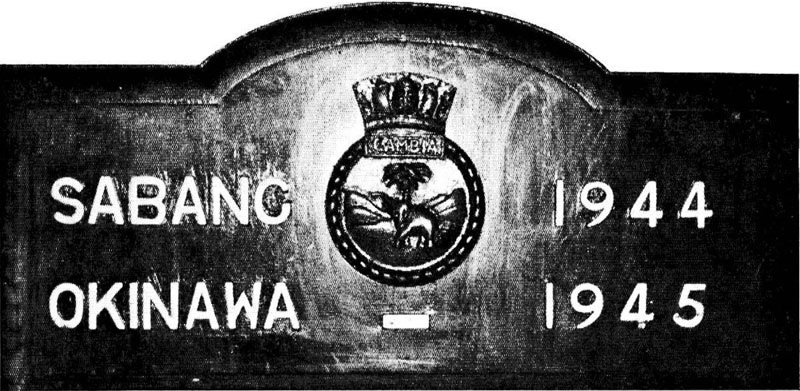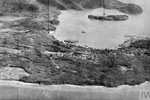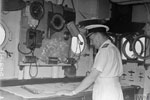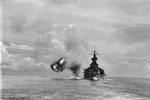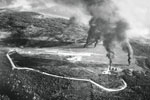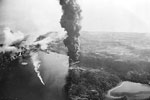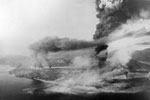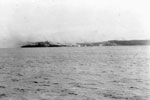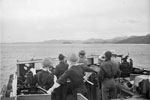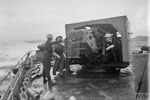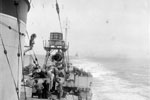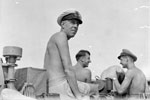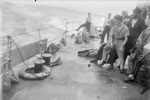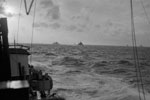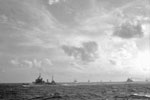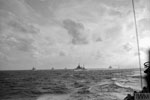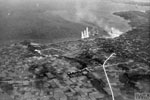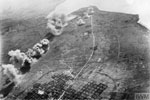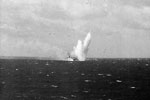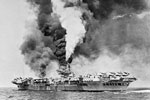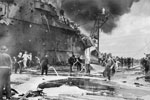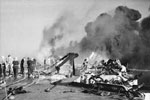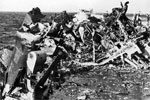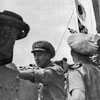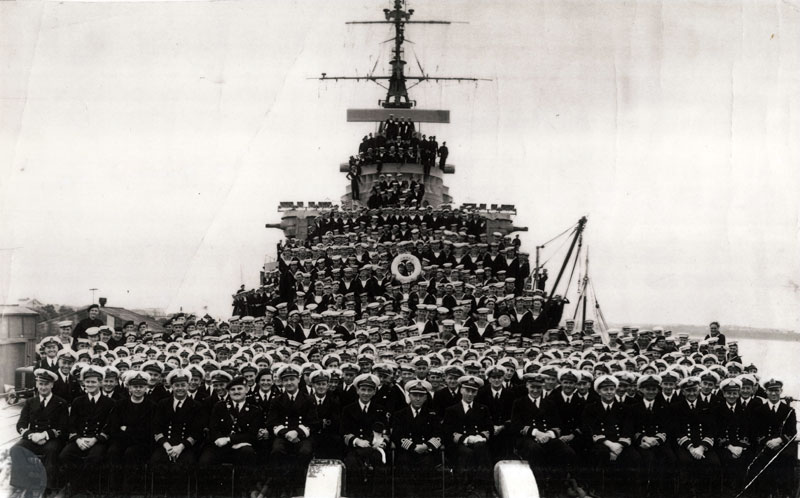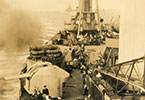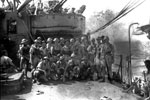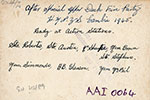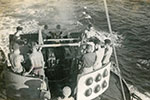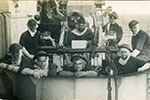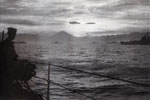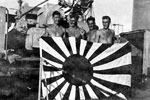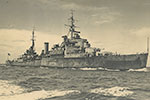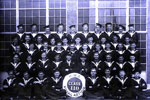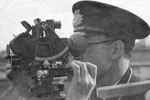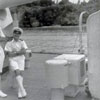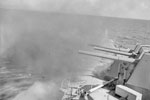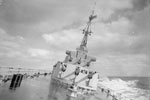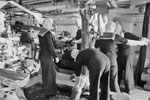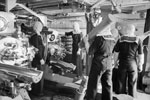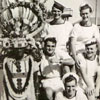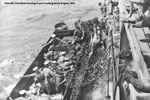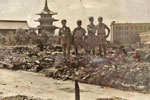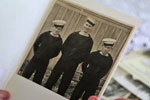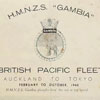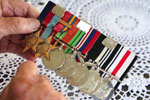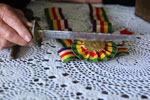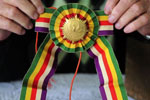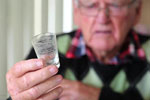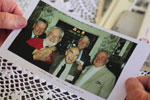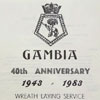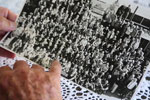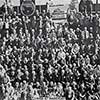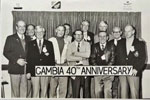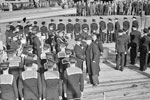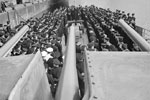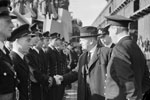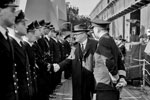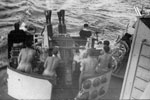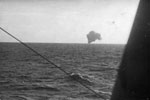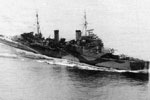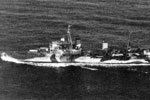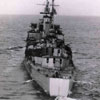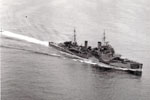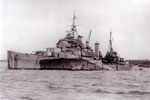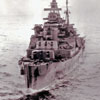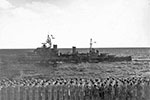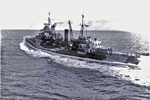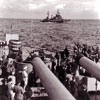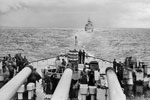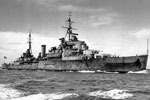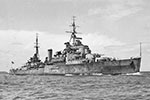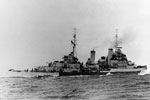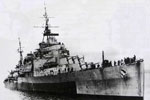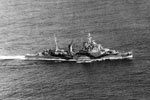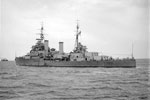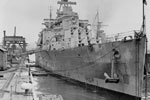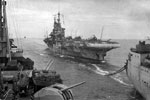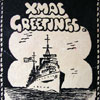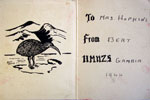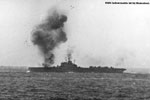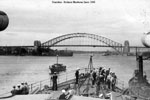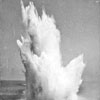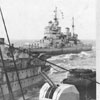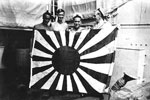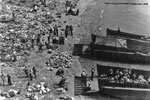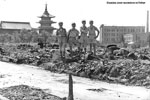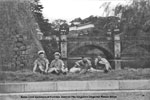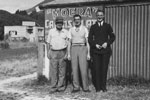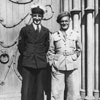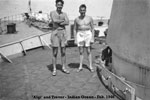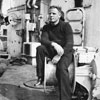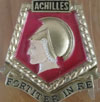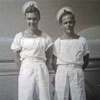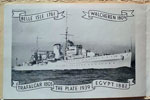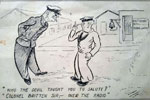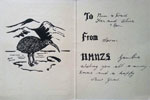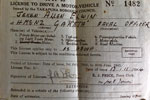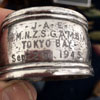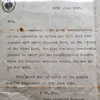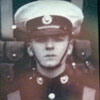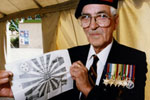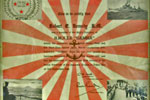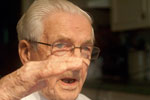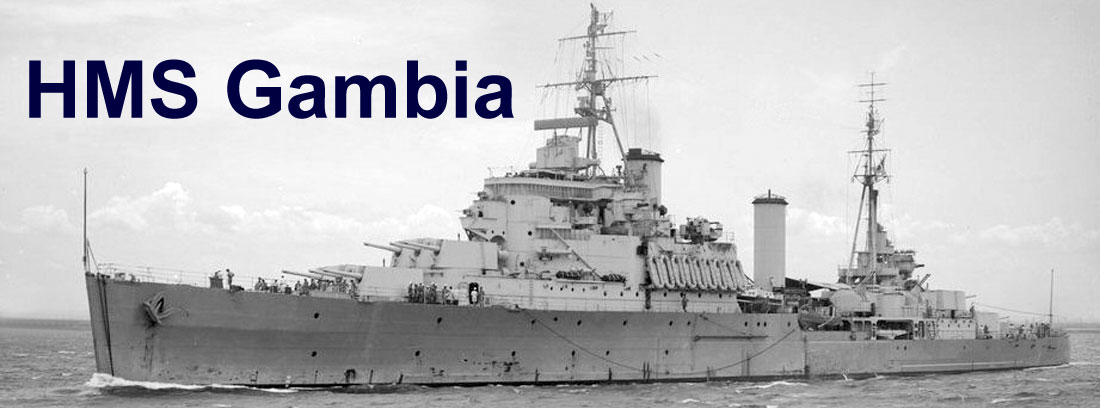
HMNZS Gambia - 1943 to 1946 - The New Zealand Years


A brief note on the Royal New Zealand Navy
Originally, the British Royal Navy was solely responsible for the naval security of New Zealand. The passing of the Naval Defence Act 1913 created the New Zealand Naval Forces as a separate division within the Royal Navy. The New Zealand Division of the Royal Navy also known as the New Zealand Station was formed in 1921 and remained in existence until 1941.
With the outbreak of World War II in 1939, New Zealand promptly declared war against Germany and the Axis powers, and expanded its naval forces. In recognition that the naval force was now largely self-sufficient and independent of the Royal Navy, the New Zealand Division of the Royal Navy became the Royal New Zealand Navy (RNZN) in 1941.
HMNZS Leander and HMNZS Achilles had already been damaged in the war and it was decided in discussions with the Royal Navy Admiralty that Gambia would be recommissioned as HMNZS Gambia, for the use of the Royal New Zealand Navy.
Gambia was transferred to the Royal New Zealand Navy on September 22, 1943 with a formal ceremony in Liverpool on October 3, 1943 but the was not formally handed over until May 8, 1944. She came under the command of Captain Newton James Wallop William-Powlett, DSC, RN on August 24, 1943 who stayed with her until March 15, 1945. She served with the British Pacific Fleet, and participated in attacks on Japanese positions throughout the Pacific. In February 1944, she was searching for blockade runners in the Cocos Islands area. She also supported a series of carrier raids against oil installations and airfields. She took part in the battle at Sabang in April, 1944; Surabaya in May; another attack on Sabang in July; and took part in the bombardment of the Japanese city of Kamaishi on August 9. She was in Trincomalee on October 6, 1944 for a short refit then she went to Australia and New Zealand, arriving in Wellington on November 4, and a five-week refit in Auckland in December, 1944.
After exercises in Hauraki Gulf, Auckland in February 1945, Gambia sailed to Sydney and from there to the naval base at Manus in the Admiralty Islands for more exercises. She rejoined the British Pacific Fleet (BPF) and took part in the attacks on the Sakishima Islands to stop the Japanese there joining the defence of Okinawa. On March 31, the destroyer HMS Ulster was disabled by a near miss that seriously damaged her engine and after boiler rooms, killing two sailors and seriously injuring another. The next day Gambia took it in tow to Leyte Gulf in the Philippines. The 760 mile trip took three days at an average towing speed of 8 knots and was the longest of its type at the time.
Gambia rejoined the battle but on April 13, accidentally shot down a United States Navy Hellcat fighter with the port pom-pom. The attack ended on April 20, and the fleet made its way back to Leyte Gulf. Gambia had spent 62 days at sea and her boilers were in some need of repair. While at Leyte, on April 28, Captain Ralph Alan Bevan Edwards, CBE RN relieved Captain Newton James Wallop William-Powlett, DSC, RN as commander of HMNZS Gambia.
On May 1, 1945 the BPF, now designated Task Force 57 left Leyte Gulf to resume operations against the Sakishima islands south-east of Okinawa. On May 4, Gambia in company with HMS Swiftsure carried out a simultaneous bombardment on Nobara Airfield with air cooperation for spotting. A successful bombardment was reported. Air strikes were continued against Sakishima Gunto until May 25, when after refueling, Task Force 57 set course for Manus. Gambia left for a refit in Sydney on May 30, arriving there on June 5. She spent several weeks in port replenishing, apart from a two day exercise at sea carrying out gunnery practice.
She left Sydney on June 28 to rejoin the BPF, which by now had been redesignated at Task Force 37 and was attacking mainland Japan. On board was Rear Admiral Eric James Patrick Brind, CBE, commanding Fourth Cruiser Squadron and his staff who were transferred to HMS Newfoundland on June 30. Gambia refuelled at Manus and on July 6, joined the BPF as part of the carrier defense during bombing operations against North and South Honshu.
Rear Admiral RM Servaes, CBE commanding the Second Cruiser Squadron and two of his staff officers joined Gambia temporarily to gain experience of fleet operations in the combat area. Gambia later rejoined Task Force 37, and the whole force carried out more air strikes against South Honshu on July 28 and 30. During July, Gambia spent thirty days at sea and steamed 10,561 miles.
On August 9, the day the atomic bomb "Fat Man" was dropped on Nagasaki, Gambia was attacking the steel works at Kaimashi on Honshu Island under the command of Rear Admiral Eric James Patrick Brind, CBE, commanding Fourth Cruiser Squadron. On the return trip to rejoin the BPF, the group was attacked by Japanese aircraft, one of which was shot down by Gambia.
Further air strikes were carried out over Northern Honshu until, on August 15, Command Task Force made a signal, "Cease Hostilities against Japan." Gambia was under attack by Japanese aircraft at the time that the ceasefire was announced and possibly fired some of the last shots of World War II. While the cease-fire signal was still flying, Spitfires were overhead engaging a Japanese aircraft. The latter dropped a bomb, which fell into the sea between HMS Indefatigable and Gambia. The enemy aircraft was shot down by the Spitfires, a part of it falling on board Gambia. No further enemy air attacks were made, but several snoopers were shot down by patrolling aircraft out of sight of the fleet, which retired to await events.
Cease fire order reply and Judy 33 identification
In reply to the cease fire order Gambia sent the message "Judy 33 shot down over fleet while signal was flying. C. T. F.’s instructions not obeyed."
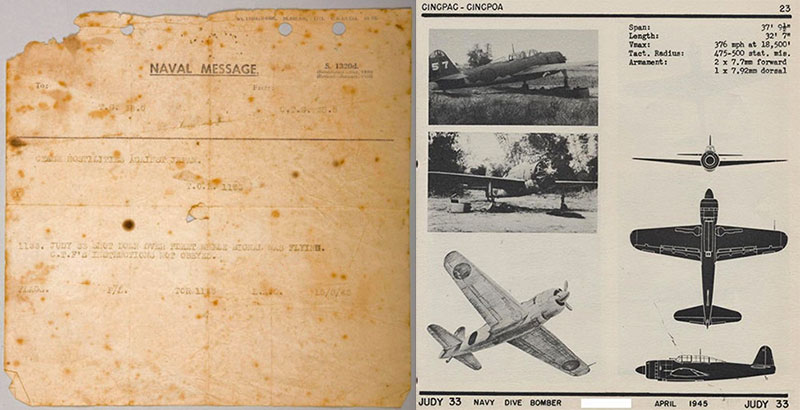
Photos: Cease fire reply: "Quiet Papamoa Commemoration of 75 Years"
Judy 33 (Yokosuka D4Y Suisei ("Comet")): Japanese Operational Aircraft CinCPOA 105-45 "Know Your Enemy!"
On August 18, 1945, the Buckley-class destroyer escort USS Pavlic rendezvoused with the British Pacific Fleet, and on August 20, took on board a Royal Navy and Royal Marine landing force from HMS Newfoundland and HMNZS Gambia. The platoon of Royal Marines, were led by Captain Blake, RM and two platoons of seamen from Gambia with company headquarters under the command of Lieutenant-Commander G.R. Davis-Goff DSC, RNZN took the surrender of the Japanese Naval Base at Yokosuka. They were reported to be the first ashore on Japanese soil.
On August 23, the Fleet formed into Task Groups for entry into Sugami Wan. Gambia in company with HM Ships King George V, Newfoundland, Napier, and Nizam formed Task Group 37. It was, however not until August 27, that the ships entered Sugami Wan. Hands went to general quarters ready for any treacherous move on the part of the Japanese, and battle ensigns were flown, but the entry was without incident. Afterwards, the Commander-in-Chief of the BPF, Admiral Sir Bruce Fraser GCB, KBE paid an informal visit to Gambia and addressed the ship’s company.
HMNZS Gambia was present on September 2, 1945 in Tokyo Bay for the signing of Japanese Instrument of Surrender. On September 12, she proceeded to Kii Suido, where she was employed until September 19 assisting United States Forces with the embarkation and recovery of Allied military personnel. While here a very severe typhoon was experienced.
On September 12, 1945, the CinCBPF, Admiral Sir Bruce Fraser arrived at Buckner Bay in HMS Duke of York. He ordered HMNZS Gambia and the destroyer HMAS Nizam to Wakayama to assist in the evacuation of allied POWs. There were estimated to be 10,000 of them in the area. The two ships arrived the next day and immediately put all their facilities at the disposal of the Commander, Evacuation Unit. Japanese civil authorities continued to be cooperative; there was little contact with Japanese military or naval authorities. The POWs were brought back to Tokyo.
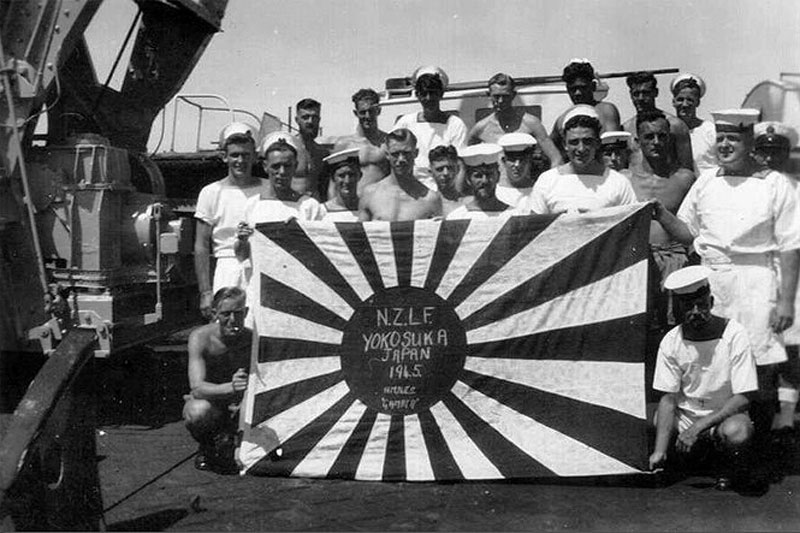
HMNZS Gambia's crew with a captured Japanese flag
The man on the bottom left of this photo is Ray Goddard who was part of "B" turret gun crew.
The writers and contributors of the RNZN Communicators Association have been a wonderful source of information. In November 2018, Shane Scott wrote that the crew member 4th from the right in the above photo looks like his granddad, Lindsy Cummings. Lindsy served on HMS Gambia from 1943 to 1946 as radar operator and pom-pom gunner. Lindsy passed away around 1994. The man on the far left is believed to be Robert "Bob" Harvey
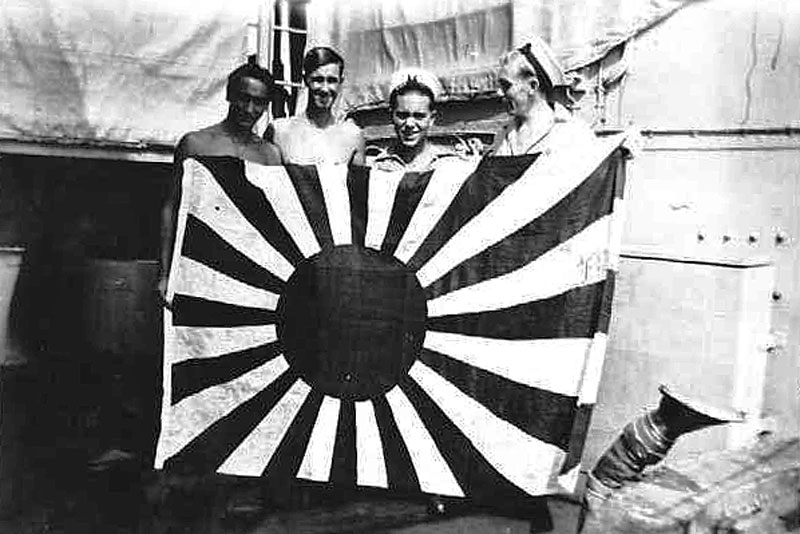
The photo above was kindly provided by Peter Bennett
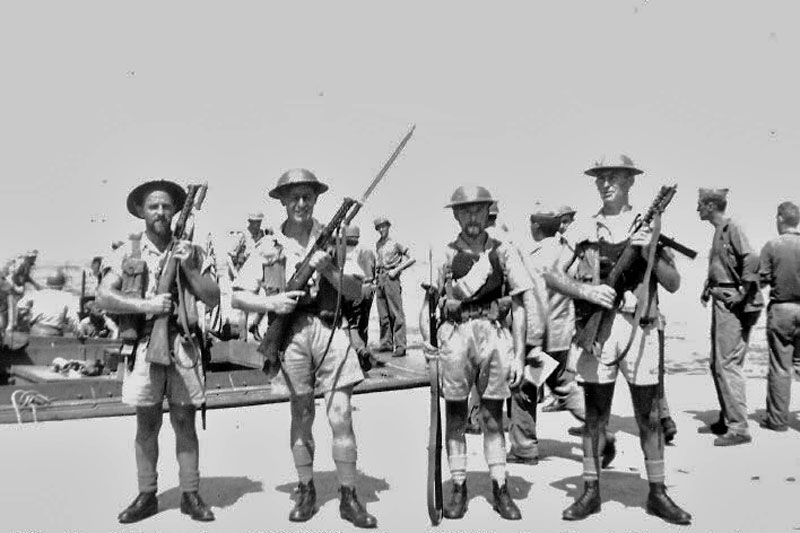
Royal Marines from HMNZS Gambia (or possibly HMS Newfoundland) at the dock of Island Fort #2 in Tokyo Bay on August 30, 1945. One American observer said that "The British marines were apparently a seasoned group of guys who'd been at war for a good six years. In spite of their WW I steel helmets, you had to take them seriously. They came ashore ready for trouble, but fortunately, there wasn't any."
She sailed from Japan for Auckland on October 11, arriving on October 30. After a six week refit, Gambia remained at Auckland until February 8 1946 and sailed for Sydney on February 12. At Sydney, the New Zealand crew were replaced by British sailors With a crew of about 1,000, Gambia headed for Melbourne where a large quantity of gold to be sent back to the UK was loaded.
Gambia was returned to the Royal Navy at Portsmouth on March 27, 1946. She underwent a refit and was recommissioned on July 1, 1946 for the 5th Cruiser Squadron with the Far East Fleet.
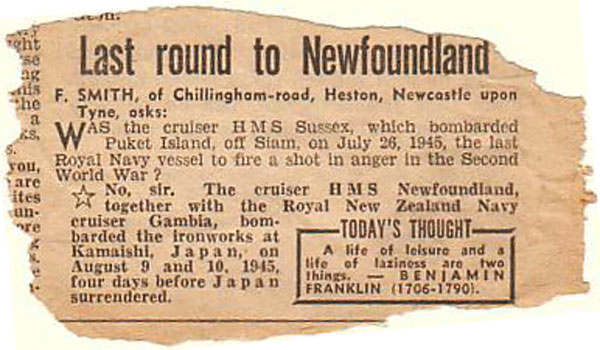
Sabang 1944
There were two attacks on the Japanese held bases at Sabang on the coast of Java, Indonesia, Operation Cockpit on April 19, 1944 and Operation Crimson on July 25, 1944. HMNZS Gambia took part in both, but it was for the second attack that she was awarded the Sabang Battle Honour. The attacks were planned by Admiral Sir James Fownes Somerville GCB, GBE, DSO, DL (July 17, 1882 – March 19, 1949) in response to a request by the United States for a distraction from their own operations on Hollandia.
On April 16, 1944, British Task Force 69 under the command of Admiral Somerville, departed Trincomalee, Ceylon (Sri Lanka). The task force consisted of battleships HMS Queen Elizabeth, the French Richelieu, HMS Valiant; the cruisers HMS Ceylon, HMNZS Gambia, HMS Newcastle, HMS Nigeria, and the Dutch Hr. Ms. Tromp; and the destroyers HMS Napier, HMS Nepal, HMAS Nizam, HMS Penn, HMS Petard, HMAS Quiberon, HMS Racehorse, HMS Rotherham, and the Dutch Hr. Ms. Van Galen.
Task Force 69 was joined by British Task Force 70 under the command of Vice Admiral Arthur J. Power. Task Force 70 consisted of the aircraft carriers HMS Illustrious and USS Saratoga, the battle cruiser HMS Renown, the cruiser HMS London; and the destroyers USS Cummings, USS Dunlap, USS Fanning, HMS Quadrant, HMS Queenborough, and HMS Quilliam.
On April 18, 1944, the cruisers HMS Ceylon and HMNZS Gambia were transferred to Task Force 70 to strengthen the aircraft carrier defences.
At 0530 on April 19, 1944, Admiral Somerville launched Operation Cockpit. Installations around Sabang and Lho Nga airfield were attacked from both the air and sea, but mostly from the air. The attack caught the Japanese by surprise and there was no fighter opposition. Between 21-30 aircraft were destroyed on the ground, IJN transport Kunitsu Maru, IJA transport Haruno Maru and minelayer IJN Hatsutaka were all damaged. The oil tanks, power-station, barracks and wireless station were also badly damaged.
The attack was so successful that Admiral Somerville was quoted as saying "the Japanese were caught with their kimonos up."
On July 22, 1944, Admiral Somerville's British Eastern Fleet departed Trincomalee. The Fleet consisted of the aircraft carriers HMS illustrious and HMS Victorious; the battleships, the French Richelieu, HMS Queen Elizabeth, HMS Valiant; the battlecruiser HMS Renown, the cruisers HMS Ceylon, HMS Cumberland, HMNZS Gambia, HMS Kenya, HMS Nigeria, HMS Phoebe, and the Dutch Hr. Ms. Tromp; the destroyers HMS Racehorse, HMS Raider, HMS Rapid, HMS Relentless, HMS Rocket, HMS Roebuck, HMS Rotherham, HMS Quality, HMAS Quickmatch, and HMS Quilliam; and the submarines HMS Tantivy and HMS Templar that were used for air-sea rescue.
On July 25, 1944, Admiral Somerville launched Operation Crimson and Sabang once again came under attack from the air and sea. That the Royal Navy was able to successfully engage Japanese shore installations showed how much the tide of war had turned, and how Japanese shore based aircraft had weakened since the loss of Prince of Wales and Repulse in 1941 north-east of Singapore. Operation Crimson was the final event of Admiral Somerville's military command before concerns about his health forced his transfer from active to diplomatic duty. He spent the remainder of the war in charge of the British naval delegation in Washington, D.C.
Okinawa 1945
The Battle of Okinawa, codenamed Operation Iceberg, was a series of battles fought in the Japanese Ryukyu Islands, centered on the island of Okinawa, and included the largest amphibious assault in the Pacific War during World War II, the April 1, 1945 invasion of Okinawa itself. The 82-day-long battle lasted from April 1 until June 22, 1945. The Allies were planning to use Okinawa, a large island only 340 mi (550 km) away from mainland Japan, as a base for air operations for the planned invasion of the Japanese home islands.
By 1942, the Japanese had pushed Britain out of the Pacific, Bay of Bengal, and eastern Indian Ocean having taken over most of the Far East (the area including Burma, Hong Kong, Indonesia, Malaysia, The Philippines, Singapore, and Thailand).
At the Second Quebec Conference, on September 13, 1944, Churchill offered a British fleet help the Americans in the war again Japan. President Roosevelt accepted the idea but Admiral Ernest King was set against it and was reluctantly persuaded by Roosevelt's and his own staff to accept it as well. Some say King was an Anglophobe, but he certainly did not want to share the glory of defeating Japan with any other nation. William Halsey, the Commander of the US Fleet wrote that "it was imperative that we forestall a possible postwar claim by Britain that she had delivered even a part of the final blow that demolished the Japanese fleet."
Churchill too had ulterior motives for offering British aid, in his memoirs he said that "I was determined that we should play our full and equal part in it. What I feared most at this stage of the war was that the United States would say in after-years 'We come to your help in Europe, and you left us alone to finish off Japan.' We had to regain on the field of battle our rightful possessions in the Far East, and not have them handed back to us at the peace table."
The British Pacific Fleet (BPF) has been called the "Forgotten Fleet." The part it played in the attacks on Okinawa largely ignored or even discredited in some histories and the role the Commonwealth countries such as Australia, Canada, and New Zealand in the BPF largely forgotten outside their own countries. But, whatever the politics of it, material aid was freely given by America to the BPF and it did play an important part in the Pacific war.
The BPF made up Task Force 57 under the command of Vice-Admiral Sir Bernard Rawlings GBE KCB (May 21, 1889 – September 30, 1962). The Task Force first attacked the islands of Sakishima south-east of Okinawa for most of March, starting on March 4, 1945. HMNZS Gambia and HMS Swiftsure in May, bombarded the Nobara airstrip, during which Gambia fired 230 rounds of 6-inch shells. The strikes against Sakishima continued until the May 25, when the Fleet went to Leyte Gulf for rest.
The Task Force then reinforced Vice-Admiral Mitscher's Task Force 58 which was the US Navy's aircraft carrier force and main element of Admiral Spruance's 5th Fleet.
Admiralty Message to the Fleet, 16 August 1945:
The surrender of the Japanese Empire brings to an end six years of achievement in war unsurpassed in the long history and high tradition of the Royal Navy.
The phase of naval warfare which came to an end three months ago enriched the record of British sea power by such epic actions and campaigns as the Battle of the Atlantic, the domination of the Mediterranean, the maintenance of the Russian supply lines and the great combined operations of 1943 and 1944. The world-wide story completed with the inspired work by sea and air of the British Pacific Fleet and the East Indies Fleet.
The Board are deeply conscious of the difficulty and novelty of the problems facing the British Pacific Fleet, the patience and skill with which they were overcome, and the great contribution in offensive power made by the Task Force operating with our American Allies. No less memorable is the work of the East Indies Fleet in the protection of India and Ceylon and in operational support of the Burma campaign.
At this moment our eyes are turned to the Far East and it is fitting to recall In remembrance those who gave their lives in the days of disaster in 1941 and 1942. To their relatives and to the relatives of all officers and men of the Royal Navy and Royal Marines and of the Naval Forces of the Commonwealth and Empire and of all in Admiralty service who have paid the full price of victory the Board extend their profound sympathy.
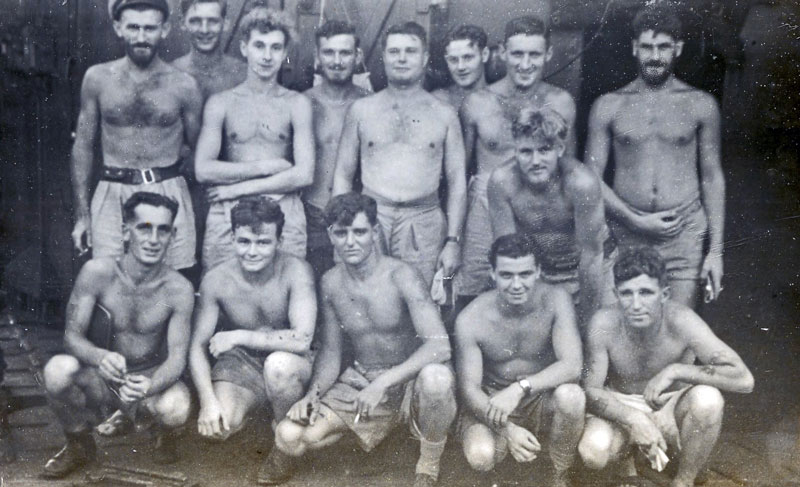
"B" Turret guns crew in 1945
Able Seaman Ray Goddard is back row, 2nd from left
Ray wrote about the last hours of WWII while he was on HMNZS Gambia for the Auckland Museum Online Cenotaph
On August 27th, 1945, we had last received orders to move into Japanese waters….It was a slow journey and an anxious few hours. We were all at action stations with guns loaded and ready to hit pre-selected targets. Apart from the concern of mine fields everyone thought a last ditch all out attach by suicide planes was a distinct possibility. Our aircraft carriers with their destroyer escorts stayed well out to sea but sent hundreds of planes to give us added protection. After so long at sea constantly on the alert, with the ship pitching and rolling in heavy seas the tranquility of being at anchor was intensely moving and enhanced by a glorious sunset against the backdrop of Mt Fujiyama. Then as the sun went down and sounds of the ships bugle echoed across the bay all sailors on deck stood to attention, faced aft and saluted as our flag was lowered for the day. Very very emotional! The war had really ended!
Peter Ngamoki was a Petty Officer Stores Assistant who served on HMNZS Gambia during WWII. His son, Willy, very kindly sent this photo of the crew of HMNZS Gambia:
The photo is full of marvellous detail, but these two are particularly striking:
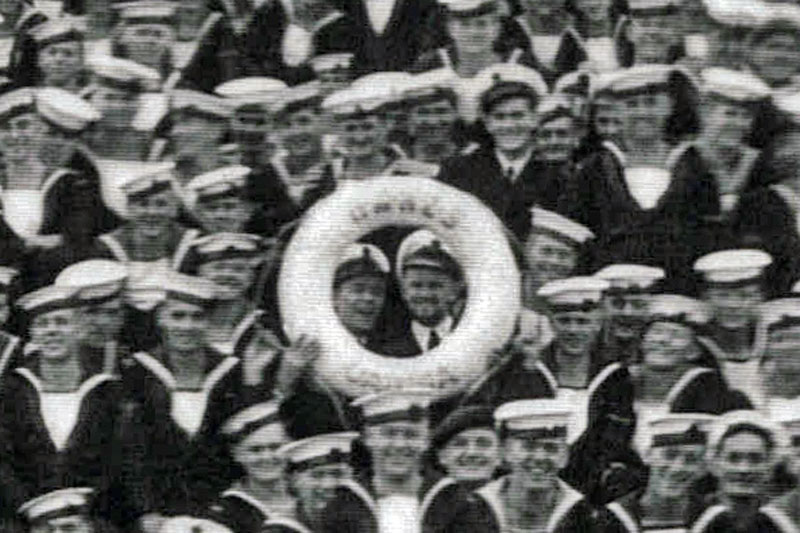
 This ensign turned up in an auction in 2009 and, along with a couple of other items; two pennant flags, the 1944 Christmas menu printed on card, a cloth patch, two commemorative certificates and a colour photograph of the vessel at sea. was valued at NZ$4,000 - NZ$8,000 (US$2,763 - US$5,526; £2,112 - £4,225).
This ensign turned up in an auction in 2009 and, along with a couple of other items; two pennant flags, the 1944 Christmas menu printed on card, a cloth patch, two commemorative certificates and a colour photograph of the vessel at sea. was valued at NZ$4,000 - NZ$8,000 (US$2,763 - US$5,526; £2,112 - £4,225).
The ensign is signed by numerous crew members and inscribed "HMNZS Gambia Tokyo Bay, September 2nd 1945."
The ensign was originally owned by D. J. Hansen, a crew member who was present at Tokyo Bay in September 1945.
Presumably this is the same lot that appeared on eBay in October 2017 for US$3,000 (£2,294).

On the original site this set of photos had AAI in the file names. I thought they may be someone's initials but in August 2020, Rachael Stallard, Photographic Archivist at the National Museum of the Royal New Zealand Navy emailed me to say that AAI was their object ID code for Gambia code and AAM is theirs for HMNZS Black Prince. Black Prince and HMNZS Bellona replaced the cruisers Gambia and Achilles shortly after the Second World War.
Not only did the National Museum of the Royal New Zealand Navy let me keep the files on the site but Rachael very kindly sent me more!
I do not know why these photos which are concerned with HMNZS Black Prince were on the original HMS Gambia site, but they are included here for completeness.
James (Jim) Murray (NZ 7998)
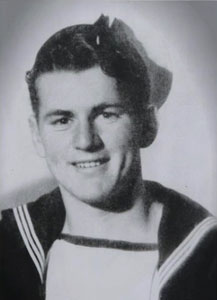
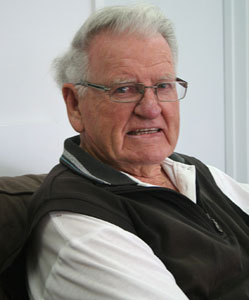
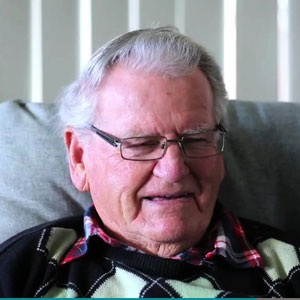

James Murray as a young man, and in 2013, and 2016
James (Jim) Murray (NZ 7998) was one of the gun crew of 'A' Turret of HMNZS Gambia. His job was to load the cordite. In 2013, Jim was one of a delegation of veterans who was flown to Noumea, New Caledonia to commemorate the 70th anniversary of the war in the Pacific. In this 2016 video he describes his experiences during WWII on the ship. Jim was born in 1928 and was 88 when this video was recorded in 2016.
Video: https://www.nzonscreen.com/title/memories-service-james-murray-2016
Firing Last Shots - Rodney Times - April 26, 2013
I made a transcript of the video's audio, and that is available here (PDF, 1Mb).

HMNZS Gambia 1943 Christmas Menu. Scan from Keith Scott
In July 2017, Terry Craig an Electrical Mechanician on HMS Gambia's 1957/58 commission very kindly sent these photos of Christmas cards sent from a Bert on HMNZS Gambia to a Mrs Hopkins in Victoria Park, Western Australia in 1943 and 1944.
Terry explained how he managed to photograph these cards "My wife did some work for Mrs Hopkins here in Perth and they became good friends. She gave us a number of these cards. I have sent most of them to the Maritime museum in New Zealand."
Terry also remembers a little bit of trivia, "When we were stocking up with beer for our commission to the East Indies Station in 1957, a lot of it was stowed in between the bulkheads down below some storerooms. Inside the bulkhead was a painted flag of New Zealand. Must have been done when they stocked up with beer?"

A gharry in Malta in the 1940s
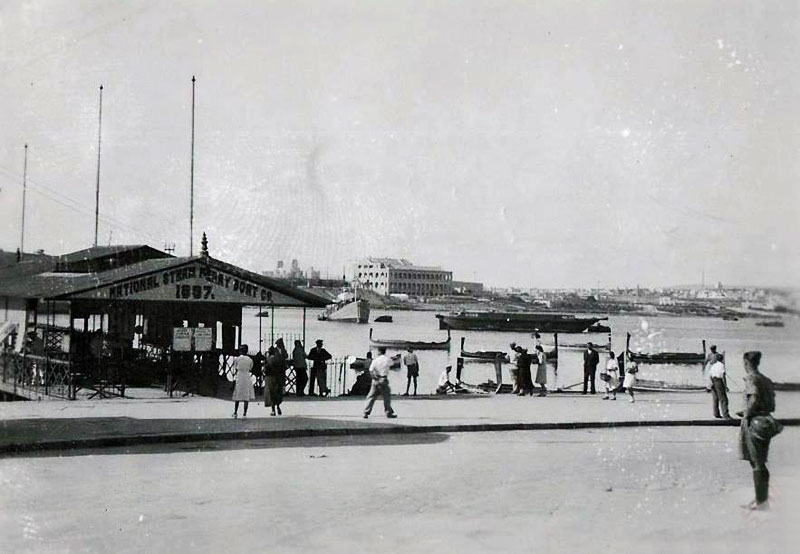
Sliema Ferry, Malta in the 1940s
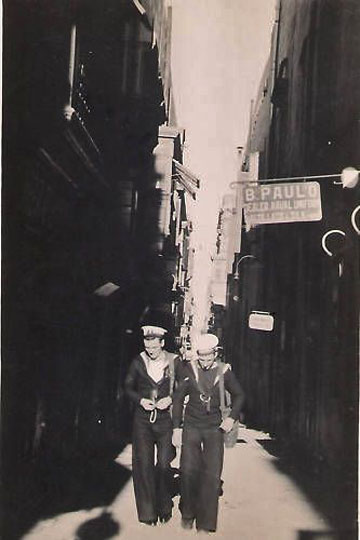
Strait Street (The Gut), Malta

This article appeared in "The Auckland Star", Christchurch, New Zealand, dated Wednesday, November 10, 1943.
The text reads:
CRUISER GAMBIA FOR R.N.Z. NAVY
THE SIX.INCH GUN CRUISER GAMBIA, which has been handed over by the Admiralty to the New Zealand navy.
( N.Z.P.A.—Special Correspondent.—Rec. noon.)
LONDON, November 9.
The Admiralty has handed over to the New Zealand Government H.M.S. Gambia, a six-inch gun cruiser of the Mauritius class. She has been commissioned for service in the Royal New Zealand Navy, and of the ship's company 75 per cent are New Zealanders.
Gambia is a modern ship and was first commissioned in February, 1942. She served in the Indian Ocean and took part in the Madagascar campaign. She has ail the most modern equipment.
The cruiser was taken over on behalf of the New Zealand Government by Mr. W. J. Jordan. High Commissioner, who visited the ship accompanied by Mr. S. R. Skinner, naval affairs officer.
Mr. Jordan read a message from the Prime Minister, Mr. Fraser, as follows: "On behalf of the New Zealand Government I wish to convey to the officers and men on commissioning the Gambia for service in the Royal New Zealand Navy the best wishes for a successful commission. We know you will add laurels to those already gained by the R.N Z. N. and that your ship will prove a source of pride to the colony whose name it bears, and which the people of Gambia have shown such great interest.
The link which you form between the Dominion of New Zealand and the colony of Gambia will, we trust, be a firm and lasting one. Kia ora."
SIMPLE CEREMONY OF HANDING OVER
DOCKSIDE SCENES
Church Service Amid Grim Reminder Of War
N.Z.P"A. Special Correspondent
Rec. 1 p.m. LONDON, Nov. 9.
The ceremony of handing over the cruiser Gambia to the New Zealand Government was a simple one. The ship's company was drawn up on the quarterdeck. Mr. Jordan was received by the commanding officer, Captain N. J. W. William-Powlett, D.S.C., R.N., who introduced him to the officers.
It was Sunday morning, so church service was held before Mr. Jordan addressed the ship's company. It was a typical naval service, the ship's company standing bareheaded as the cry of gulls mingled with the strains of the Royal Marines Band, which played the hymns, while a reminder of the war was an anti-aircraft battery, testing a few miles away and occasionally dotting the sky with black puffs of shell bursts that punctuated the prayers with explosions.
A picturesque touch was given by docksiders, who sat on places overlooking the deck and lined the dock alongside.
Mr. Jordan's Good Wishes
After the service Captain William-Powlett briefly introduced Mr. Jordan, who said that on behalf of the Government and people of New Zealand he wished the ship every success. The men of the R.N.Z.N. had already had the opportunity of serving side by side with the men of the Royal Navy, and nothing had given the people of New Zealand a greater thrill than hearing the satisfaction expressed about them by the First Lord of the Admiralty, Mr. A. V. Alexander.
Captain William-Powlett asked Mr. Jordan to convey thanks to the Prime Minister for his message and to tell him and the Government and people "that we have here a fine ship. We intend to do our utmost to make it the most efficient ship in the Fleets of the Allied Nations wherever we may serve, or in whatever units we may serve."
After this brief ceremony Mr. Jordan met officers in the wardroom and lunched with the captain, then an hour going round the ship meeting the New Zealanders in the various messes.
To his query "Well, gentlemen, how are you getting on?" they replied that they found their quarters much more cramped than in previous ships they had served in.
Mr. Jordan learned that this was accounted for by various types of new equipment which required extra personnel.
Several New Zealanders serving in Gambia formerly served in a ship well known throughout New Zealand and some in H.M.N.Z.S. Monowai.
Career of Captain
Captain William-Powlett is a brother of Captain P. R. B. W. William-Powlett, who commanded H M.S. Dunedin In when on loan to the R.N.Z.N. He won the D S.C. at Jutland as a sub-lieutenant in H.M.S. Tipperary, which was sunk in that action.
Lord Jellicoe's recommendation for the decoration stated: "This officer showed wonderful coolness under most trying circumstances and his pluck and cheerfulness after the ship was sunk were certainly the means of saving the lives of several who would otherwise have given in or succumbed. I cannot speak too highly of this officer's conduct."
Captain William-Powlett was appointed captain on December 31, 1938, commanding H.M.S. Dauntless.
When the cruiser Gambia visited Bathurst, capital of the colony in West Africa, she was opened for inspection, the Governor of Gambia referred to her as "their own ship." The colony subscribed £800 for the ship's company, and also presented a silk ensign. The Governor of Gambia has been advised that the ship has been loaned to New Zealand.
The cruiser Gambia is still on the Admiralty secret list, but according to Jane's Fighting Ships she is a vessel of 8000 tons displacement. Is 549ft In length, 62 ft beam, with a draught 16½ ft. She carries twelve 6in guns, eight 4in A.A. guns and 16 smaller guns. She also carries three aircraft with one catapult. The vessel was built at Wallsend by Swan Hunter, was laid down in 1939 and launched in 1942. She is fitted with Parsons geared turbines, developing 72,500 horse-power and a speed of 33 knots. Other vessels of the Mauritius class are: Kenya, Mauritius, Nigeria, Trinidad, Ceylon, Jamaica, Uganda, and four others, names not yet released. Gambia is a Crown colony on the West coast of Africa, south of Cape Verde.
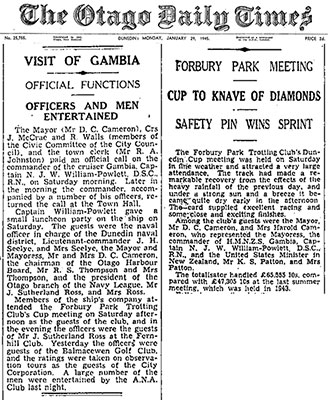
These articles appeared in The Otago Daily Times, Dunedin, New Zealand, in the Monday, January 29, 1945, edition.
The text reads:
VISIT OF GAMBIA
OFFICIAL FUNCTIONS
OFFICERS AND MEN ENTERTAINED
The Mayor (Mr D. C. Cameron), Crs J. McCrae and R. Walls (members of the Civic Committee of the City Council), and the town clerk (Mr R. A. Johnston) paid an official call on the commander of the cruiser Gambia, Captain N. J. W. William-Powlett, D.S.C. R.N. on Saturday morning. Later in the morning the commander, accompanied by a number of bis officers, returned the call at the Town Hall.
Captain William-Powlett gave a small luncheon party on the ship on Saturday. The guests were the naval officer in charge of the Dunedin naval district, Lieutenant-commander J. H. Seelye. and Mrs Seelye, the Mayor and Mayoress, Mr and Mrs D. C. Cameron, the chairman of the Otago Harbour Board, Mr R. S. Thompson and Mrs Thompson, and the president of the Otago branch of the Navy League, Mr J. Sutherland Ross, and Mrs Ross.
Members of the ship's company attended the Forbury Park Trotting Club's Cup meeting on Saturday afternoon as the guests of the club, and in the evening officers were the guests of Mr J. Sutherland Ross at the Fernhill Club. Yesterday the officers were guests of the Balmacewen Golf Club, and the ratings were taken on observation tours as the guests of the City Corporation. A large number of the men were entertained by the A.N.A. Club last night.
FORBURY PARK MEETING
CUP TO KNAVE OF DIAMONDS
SAFETY PIN WINS SPRINT
The Forbury Park Trotting Club's Dunedin Cup meeting held on Saturday in fine weather and attracted a very large attendance. The track had made a remarkable recovery from the effects of the heavy rainfall of the previous day, and under a strong sun and a breeze it became quite dry early in the afternoon. The card supplied excellent racing and some close and exciting finishes.
Among the club's guests were the Mayor, Mr D. C. Cameron, and Mrs Harold Cameron, who represented the Mayoress, the commander of H.M.N.Z,S. Gambia, captain N. J. W. William-Powlett. D.S.C., R.N., and the United States Minister in New Zealand, Mr K. S. Patton, and Mrs Patton.
The totalisator handled £65,555 10s compared with £47,305 10s at the last summer meeting, which was held in 1943.

This article appeared in "The Press", Christchurch, New Zealand, dated Wednesday, January 31, 1945.
The text reads:
CRUISER VISITS LYTTELTON
ARRIVAL OF H.M.N.Z.S. GAMBIA
Commanded by Captain N. J. W. William-Powlett, D.S.C., R.N., the cruiser Gambia, the most powerful vessel of the Royal New Zealand Navy, arrived at Lyttelton yesterday morning. The ship will not be open to visitors during her stay at Lyttelton, but the wharf will be open to the public at certain hours.
One of a class of 12 cruisers which have been named after British Crown colonies, the Gambia is of 8000 tons. Details which have been released concerning this class give their dimensions as 549 feet with a beam of 62 feet. They were designed for a speed of 33 knots. They are armed with 12 6-inch, eight 4-inch anti-aircraft guns, and 16 smaller guns. and are designed to carry three aircraft.
The Gambia was handed over to the New Zealand Government more than a year ago, after having served the Indian Ocean and in the Madagascar campaign. The vessel now two years old.
Seventy-five per cent of the crew are New Zealand ratings. Between them they have served in most parts the world, including the battle of the River Plate. The remainder are Imperial ratings, most of them also, having a great record of service.
Award of D.S.C.
Captain William-Powlett was awarded the Distinguished Service Cross for his action in the battle of Jutland, when he was serving as a sub-lieutenant in H.M.S. Tipperary, which was sunk by the enemy. He received the following high commendation from Admiral Jellicoe:- "This officer showed wonderful coolness in most trying circumstances, and his pluck and cheerfulness after the ship was sunk were certainly the means of saving the lives of several who would otherwise have given in or succumbed. I cannot speak too highly of this officer's conduct."
Captain William-Powlett is a brother of Captain P. B. R. W. William-Powlett, well known in New Zealand as the executive officer of H.M.S. Dunedin of which he later became commander.
List of Officers
The officers of the ship are as follows:-
Captain N. J. W. William-Powlett, D.S.C., R.N.
Executive Branch. — Commander (Rtd.) D. H. Harper, R.N., Lieutenant Commander .J. A. Elwin, Lieutenant Commander J. Wilkinson. R.N., Temporary Acting Lieutenant Commander T. S. Horan, R.N.V.R., Lieutenant F. Bruen, D.S.C., R.N., Lieutenant J. E. Washbourn R.N., Lieutenant J. A. Allingham, R.N.Z.N.V.R., Temporary Lieutenant A. A. Goldier, R.N.Z.N.V.R., Temporary Lieutenant J. E. Goodwin, R.N.Z.N.V.R., Temporary Lieutenant J. D. Dunlop, R.N.V.R., Temporary Lieutenant S. F. Corrick, R.N.Z.N.V.R., Temporary Acting Lieutenant J. B. Smith, R.N.Z.N.V.R., Sub Lieutenant E. M. Lea, R.N. Temporary Sub Lieutenant O. Walmsley, R.N.Z.N.V.R.
Engine Room Branch. - Commander (E) W. V. B. Drew, R.N. Temporary Acting Lieutenant Commander (E) K. I. Lee-Richards, R.N., Lieutenant (E) C. W. H. Shepherd, R.N. Lieutenant (E) W. T. McKee, R.N.
Marines and Other Branches
Royal Marines Detachment. - Captain G. E. Blake, R.M., Lieutenant P. J. F. Whitely, R.M.
Chaplain. - The Rev. T. R. Parfitt, R.N.V.R.
Medical. - Temporary Acting Surgeon Lieutenant Commander A. K. Cumming, M.B., Ph.B., M.R.C.O.G., R.N.Z.N.V.R., Temporary Surgeon Lieutenant R. J. W. Walton, R.N.Z.N.V.R., Temporary Surgeon Lieutenant H. P. Duan, R.N.Z.N.V.R., Temporary Surgeon Lieutenant (D) H. C. B. Wycherley, R.N.Z.N.V.R.
Accountant Branch. - Acting Paymaster Commander R. H. Allen, R.N., Paymaster Lieutenant O. R. J. Skyrne, R.N.Z.N., Temporary Paymaster Sub Lieutenant T. H. McFlynn, R.N.Z.N.V.R [Should be McFlinn? As this should be Thomas Hansen McFlinn?]., Temporary Paymaster Sub Lieutenant G. P. Milnes, R.N.V.R.
Instructor. - Temporary Instructor Lieutenant H. R. Hancox, R.N.
Special Branch. - Temporary Lieutenant G. N. Bamfield, R.N.Z.N.V.R., Temporary Sub Lieutenant W. J. Willia, R.N.Z.N.V.R.
Warrant Officers. - Mr. A. E. Chapman, R.N. Mr. J. F. W. Sharpe, R.N., Mr. I. J. McNeill, R.N., Mr. R. E. Ansley R.N.Z.N., Mr. J. F. Bliss, R.N., Mr. A . W. Morris, R.N., Mr. G. W. Wilcox, R.N., Mr. A. J. Chinn, R.N., Mr. W. I. Tozer, BEM, R.N., Mr. C. J. Taylor, schoolmaster, R.N.Z.N.
Midshipmen. - Mr. K. C. Etherington, R.N.R., Mr. T. F. Fisher, R.N.R., Mr. E. J. O'Keeffe, R.N.R., Mr. M. Younger, R.N.R., Mr. J. G. Pike, R.N.R., Mr. J. E. Haigh, R.N.R.
Official Visits
Official calls were paid to the Gambia yesterday morning by the Mayor of Lyttelton (Mr. W. T. Lester) and Acting Town Clerk (Mr. J. Thomson); the Mayor of Christchurch (Mr. E. H. Andrews and the Town Clerk (Mr. H. S. Feast): the deputy-chairman of the Harbour Board (Mr. W. S. MacGibbon) and the Habourmaster (Captain J. Plowman), and by the chairman of the Navy League, Mr. A. S. Taylor, and Commander C. H. Kersley. Captain William-Powlett later returned the calls.
Arrangements for the entertainment of the officers and ratings of the Gambia during her stay in port have been made by the Canterbury branch of the Navy League. Last evening the officers a dance in the National Club rooms, and this evening 400 men will be entertained at a dance at the Welcome Club. Tomorrow 90 ratings will visit Rangiora, where they will be the guests of the Mayor and citizens.
A small interlude in the war was recorded by the Royal Canadian Navy's "The Signal Log" of July 1945.
"Redskins" from "Uganda" Place Second in Novel War Canoe Race
With the British Pacific Fleet — The "Maoris" of New Zealand and the "Redskins" of Canada showed the way when ships of the British Pacific Fleet held a war canoe race during a lull in operations recently.
Men from the New Zealand-manned cruiser H.M.S. Gambia nosed out the Canucks by half a boat-length to place first in the race, which was witnessed by thousands of officers and men lining the decks of powerful carriers, battle-wagons and other ships. Sixteen other ships of the fleet were represented in the race.
Many of the crews showed up at the starting line in full war paint, headdress and regalia, complete with tom-toms to inspire the paddlers. Uganda arrived on the scene with a striking Totem Pole at the head of the boat, the work of Lieut. J. G. Mills, of Toronto. Whalers had to be used as "canoes".

This article appeared in "The Press", Christchurch, New Zealand, and "The Evening Post", Wellington, New Zealand both dated Thursday, August 16, 1945.
The text reads:
ACHLLES AND GAMBIA
CRUISERS EXPECTED AT AUCKLAND
(PA) AUCKLAND. August 15
It is expected that the two New Zealand cruisers Achilles and Gambia, both of which have actively engaged in the war against Japan as units of the British Pacific Fleet will return to Auckland shortly. Arrangements are in hand for a procession of officers and ratings through the city and for a civic reception.
No information about the arrival of the two ships was available from the naval authorities. Their movements are still classified as a "top secret." However, it is believed that the Gambia will arrive in company with the Achilles, and possibly a third ship, at the beginning of next week. Plans are for the civic reception and the procession to be held on Tuesday.
The Gambia is commanded by Captain Ralph Edwards, who succeeded Captain N. J. W. William-Fowlett shortly before the ship sailed from an advanced Pacific base late in March for her first operation with the British Pacific Fleet. Captain Edwards was formerly chief of staff to the Commander-in-Chief, Eastern Fleet, Admiral Sir James Somerville. The Achilles is commanded by Captain F. J. Butler, who was in command of her when visited Auckland early this year. He later took the Achilles on a visit to southern New Zealand ports before the cruiser joined the British Pacific Fleet at sea late in May.
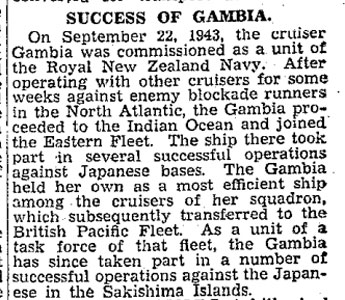
This article also appeared in "The Evening Post", Wellington, New Zealand dated Thursday, August 16, 1945.
SUCCESS OF GAMBIA
The Japanese were actively using suicide bombers, which were a serious menace and inflicted a large amount of damage, and Admiral Nimitz paid a high tribute to the contribution the British ships made to his operations by keeping these dangerous agents away. H.M.N.Z.S. Gambia was among the cruisers with Admiral Bruce's fleet.
On September 22, 1943, the cruiser Gambia was commissioned as a unit of the Royal New Zealand Navy. After operating with other cruisers for some weeks against enemy blockade runners in the North Atlantic, the Gambia proceeded to the Indian Ocean and joined the Eastern Fleet. The ship there took part in several successful operations against Japanese bases. The Gambia held her own as a most efficient ship among the cruisers of her squadron, which subsequently transferred to the British Pacific Fleet. As a unit of a task force of that fleet, the Gambia has since taken part in a number of successful operations against the Japanese in the Sakishima Islands.
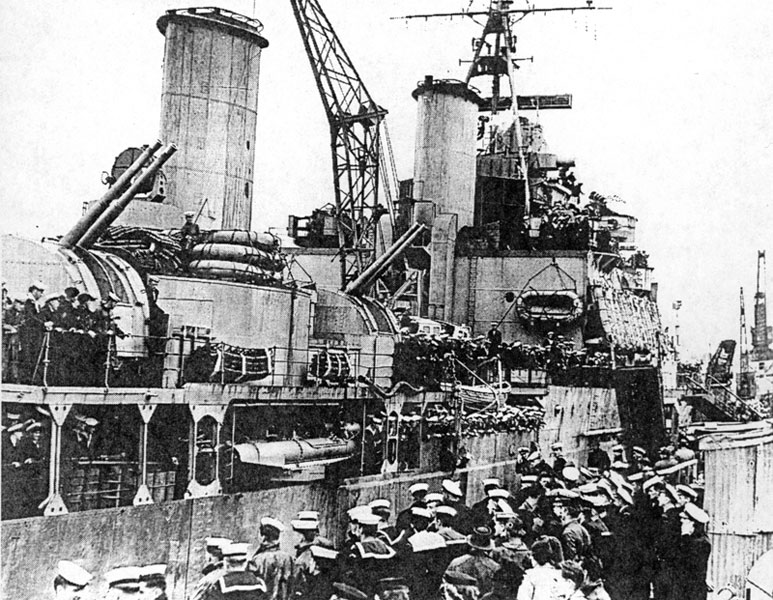
HMNZS Gambia tied up at Auckland, New Zealand, October 1945.
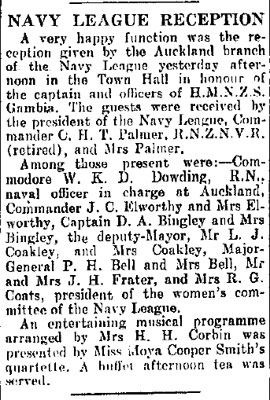
This article comes from The New Zealand Herald, Auckland, Thursday, November 1, 1945:
Navy League Reception
A very happy function was the reception given by the Auckland branch of the Navy League yesterday afternoon in the Town Hall in honour of the captain and officers of HMNZS Gambia. The guests were received by the president of the Navy League, Commander C. H. T. Palmer, RNZNVR (retired), and Mrs Palmer
Among those present were:- Commodore W. K. D. Dowding, RN, naval officer in charge at Auckland, Commander J. C. Elworthy and Mrs Elworthy, Captain D. A. Bingley and Mrs Bingley, the deputy-Mayor, Mr L. J. Coakley, and Mrs Coakley, Major-General P. H. Bell and Mrs Bell, Mr and Mrs J. H. Frater, and Mrs R. G. Coats, president of the Women's committee of the Navy League.
An entertaining musical programme arranged by Mrs H. H. Corbin was presented by Miss Moya Cooper Smith's quartette. A buffet afternoon tea was served.
This letter was written by A.B. Douglas Scott RNZN as a souvenir of the occasion of the victory over Japan. The original on display in the RNZN Museum at HMNZS Philomel.
Tokyo Bay
2nd September 1945This is a Souvenir commemorating the Day the Surrender Terms were signed with Japan on board the American Battleship "Missouri" in Tokyo Bay. This is being written on board HMNZS Gambia, the New Zealand Representative Ship entering Tokyo bay.
The letter was kindly donated by Betty Scott, widow of George Douglas Scott, and Keith Scott, their son from Dunedin, New Zealand.
Takaka, Golden Bay, New Zealand
Many crew came from a particular area, and one of those was Takaka in Golden Bay, New Zealand. Takaka is in the north of South Island.
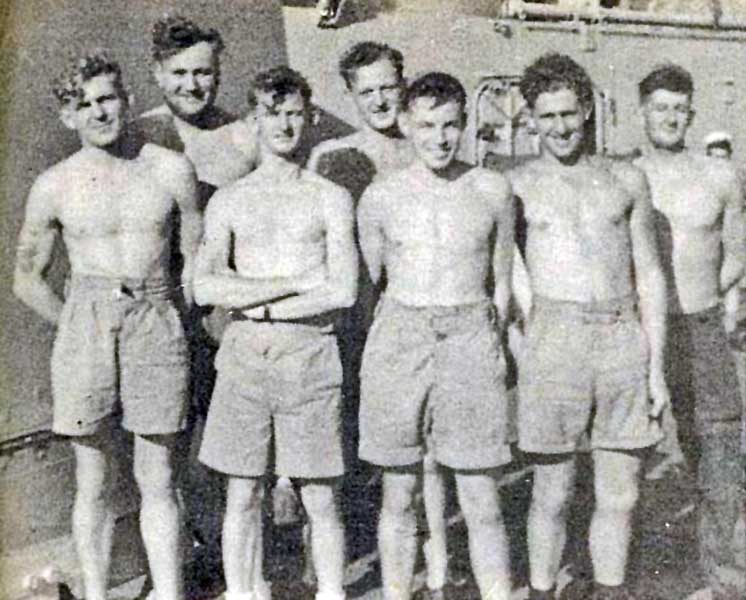
Men from Takaka, Golden Bay, New Zealand
Photo from Nelson Photo News, No 14 : December 9, 1961
The photo was given to the Nelson Photo News by Ed Peacock who served on HMNZS Gambia and Leander. Pictured from the left are Bob Papps, Charlie Stade (Motueka), Ian Feary, Ed Peacock, Norm Anderson, Watty Bird, and Dixon. Another crew member, Bruce King, was on duty when this photo was taken.
Bob Papps had a story about him printed in the Nelson Mail of April 25, 2012...
Ninety-year-old Bob Papps, of Takaka, is one of the few veterans of World War II who served in both the Mediterranean and the Pacific.
The Royal Navy ships that he helped stoke dodged Luftwaffe bombs off the Syrian coast and fought kamikazes while they shelled Japanese factories at the end of the war.
His final posting of the war was on board HMS Gambia which assisted the US Pacific fleet and shelled the eastern coast of Japan. In August 1945, Mr Papps’ ship was the last to come under attack by kamikaze pilots and narrowly avoided disaster.
"When the war ended we were there in Tokyo harbour alongside the USS Missouri for the Japanese surrender," Mr. Papps said. "I will never forget all that we went through to get there and all the men that died."
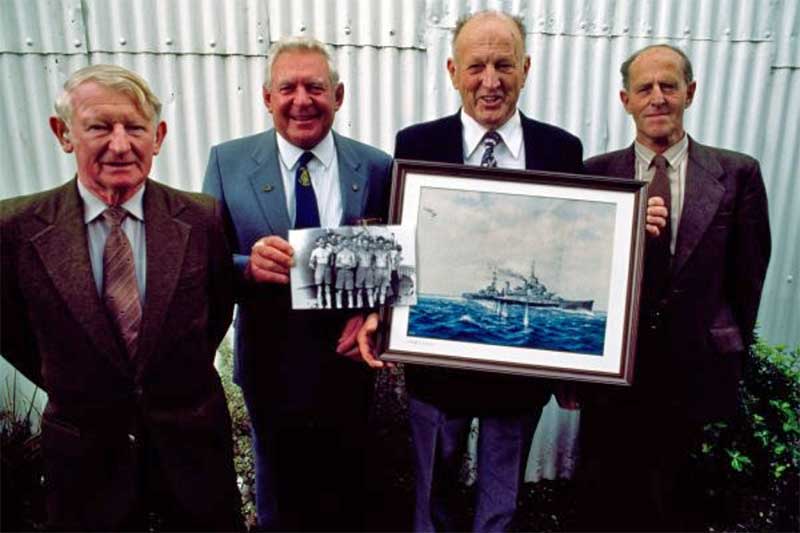
Ian Feary, Bob Papps, Eddie Peacock and Watty Bird in 1991
The men knew each other as children, joined the services together in 1939, served on HMS Gambia when it fired the last shots of World War II, and are still friends.
From New Zealand Geographic, The End of the Rainbow, Issue 10, April/June 1991. Photo by Arno Gasteiger.
You may recognize the framed print they are holding. It was used as the cover of HMNZS Gambia by Jack S. Harker. Moana Press, New Zealand, 1989
Mervyn James Beauvais NZ7980
Mervyn, a naval serviceman from Ashburton, served on the H.M.N.Z.S. Gambia as an ordinary seaman in the Pacific during the Second World War, from June 1944 to December 1945. Mervyn died on 23 September 2012, at Ashburton, Canterbury, South Island, New Zealand. He is interned in the Returned Servicesmans Section of Ashburton New Lawn Cemetery.
The Ashburton Museum & Historical Society's Whakatere Heritage Collections Online website contains lots of material from Mervyn's life such as his letters, cuttings and photographs.
George Bennett
George Bennett served on HMNZS Gambia at least between 1945 and 1946 but I do not know in what capacity. These photos were kindly donated to the original HMS Gambia Association website by Peter Bennett but I do not know the relationship between George and Peter (father/son?).
Norman James Carlyle
Norman served on HMNZS Gambia from his transfer from HMNZS Achilles, which would probably have been in 1943, until the end of the war. He was Stoker, 1st Class and is buried in the RSA Cemetery at Taupo, New Zealand, next to the flagpole.
In November 2017, his son Garry very kindly send the following images:
Keith F. Connew
Keith was a Regulating Petty Officer on HMNZS Gambia and recounted this amusing story which was published in an article named "As I Remember" edited by Kelly Ana Morey, along with the story from Able Seaman Victor Fifield. I do not know where the clipping came from, or where it was originally printed.
Gambia went to the Azores. We allowed one watch to go ashore, and they were to go ashore from midday until 4 o'clock, and the other watch was to go ashore from 5 o'clock until about 8. Jack Cameron and I said, "Well we won't go ashore first, we will go second and we will see what the place is like from others".
We never got the chance. Somehow or other they got on board, they were that drunk, we went and collected boatloads of people from the jetty and brought them on to the ship. We had people from other ships in our cells. The Captain sailed the ship at 8 o'clock the next morning and out of the way. Our watch never got a chance to go ashore.
That evening some young sailor came around the corner from somewhere and hit me on the nose. He's never been able to explain why he did that, but he was full of grog and so were many others. I will never forget when we left the Azores, we had Captain's defaulters on the quarterdeck and I think I had about 400 bottles of spirits as evidence.
Each one had a name on it and these were the spirits that had been smuggled aboard that previous night. They were charged in front of the Captain with each offence and I had to produce the evidence. Then to my horror the Captain said, "Throw it over the side", because by this time we were at sea and I had to go to the guard rail and throw these bottles one by one over the sea.
I will never forget, I had come against one chap who had smuggled a magnum of champagne. When he had come on board he looked like the hunch back of Notre Dame. Because he came up and this thing was placed up the back of his jumper, and we took it off him, put his name on it, and all the Officers at the defaulters watched me throw this magnificent bottle of champagne over the side.
The following comes from the National Museum of the Royal New Zealand Navy:
Lieutenant Keith Connew B.E.M., M.I.D. joined the New Zealand Division of the Royal Navy as a Seaman Boy in 1934. After a year of basic training at HMS Philomel, he joined the cruiser HMS Dunedin for a little over a year before being posted to the cruiser HMS Achilles in early 1937. While on board that ship Connew, by then an ordinary seaman saw action at the Battle of the River Plate and consequently was Mentioned in Dispatches. Apart from a brief time in the armed-merchant cruiser HMS Monowai he remained with HMS Achilles until early 1943 when he joined HMNZS Gambia which was based out of Ceylon, remaining on board until the end of World War II.
Having joined the regulating branch in 1942, Connew was Master at Arms in HMNZS Philomel at the time of the 1947 mutiny and provides some insight in to this incident. Apart from a year in the cruiser HMNZS Bellona, he was ashore at various establishments notably HMNZS Philomel, HMNZS Tamaki and HMNZS Cook in the Regulating Branch. In 1954 he became a recruiter for the Royal New Zealand Navy, a job he performed admirably for many years.
Keith Connew retired in August 1971 having attained the rank of Lieutenant.
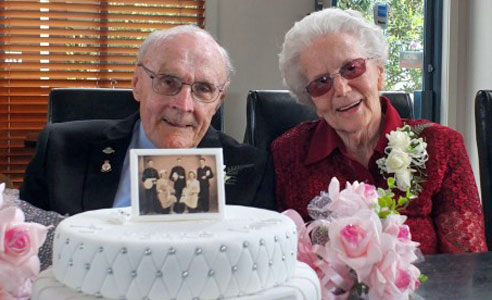 Richard Henry Coveney (RMBX1204)
Richard Henry Coveney (RMBX1204)
Richard and Jean Coveney are still living a romance cemented amidst the turmoil of World War II. The Manukau couple has celebrated their platinum - 70th - wedding anniversary surrounded by friends and family. Richard joined the Royal Marine Band Service at Deal in England in 1938 at the age of 14. Because of the war, at 18 he was drafted to the aircraft carrier HMS Argus. Later, in 1942, he was transferred to HMS Gambia, a new cruiser serving in the Indian Ocean.
After damage to HMNZS Achilles and HMNZS Leander, the Gambia was transferred to the Royal New Zealand Navy in 1943.
Meanwhile, Jean Robinson had left home to live with her sister Iolene and her husband at their home in Mt Eden.
As fate would have it, HMNZS Gambia had to spend six weeks in Auckland's Devonport Naval base from November 1944, to be refitted for operations in the Pacific. There came a knock on Iolene's door and in walked a gentleman in a Royal Marine uniform, who Jean mistook for a Salvation Army officer.
Richard had learned of a married couple that he could visit in Auckland. Little did he know that that his future bride was also living there. Towards the end of his furlough, Richard thought it best to secure his newly found soul-mate with a proposal before heading off to join the Pacific fleet.
In August 1945, Gambia was involved in the bombardment of targets in Japan. After the atomic attacks on Hiroshima and Nagasaki, the Gambia was attacking a kamikaze aircraft when the signal came through to say that the war was over. It was only a matter of weeks after the surrender was signed that the Gambia returned to Auckland.
With only a short stay, there was no time to waste and the couple were married in St. Matthew's Church.
The cruiser was about to re-enter the Royal Navy and Richard had to farewell his new bride with "I'll see you in England." Jean was soon to board the SS Tyndareus in Wellington, steaming to England. After their reunion at Tilbury, they have not been parted since.
Still in Love After all These Years - Manukau Courier - December 17, 2015
Richard was born on June 16, 1923 and passed away at Bethesda Home on October 8, 2016, aged 93.
Allan Crawford
Allan Crawford served on HMNZS Gambia as a Torpedoman 1st Class on HMNZS Gambia and was present at the Japanese surrender. RNZN and TS Gambia representatives were present at the funeral in Henderson and did a fine Haka to send him off. See RNZN Communicators Association site for original post.
Thomas Roy "Sandy" Curtis
Roy was a Royal Marine gunner who served on HMS Gambia from January 1944 to February 1946.
William (Bill) Elliot (NZD 1353) Able Seaman
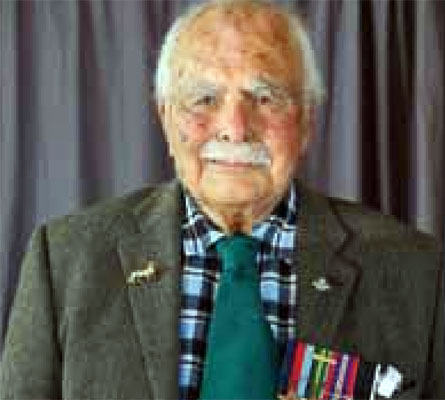 Bill Elliot went straight from school into the New Zealand division of the Royal Navy in 1935. He completed his basic training at HMS Philomel and passed with first prize in the advanced class of the school in 1936. He later served on HMS Dunedin, HMS Leander and HMS Achilles
Bill Elliot went straight from school into the New Zealand division of the Royal Navy in 1935. He completed his basic training at HMS Philomel and passed with first prize in the advanced class of the school in 1936. He later served on HMS Dunedin, HMS Leander and HMS Achilles
He joined the Armed Merchant Cruiser HMS Monowai and was later posted to HMNZS Gambia. On the Gambia he served in the Far East alongside warships from The United Kingdom, the United States and the Free French Navies. Bill was in the British Naval Base at Trincomalee, Ceylon for V E Day. He took discharge from the navy shortly afterwards.
On his return to New Zealand Bill apprenticed as a plumber and went on to establish his own successful business. He also worked for the Otago Hospital Board and was the resident plumber at Wakari Hospital.
This short piece appeared in the The Chatsford Chat in 2014
Jeken Allen Elwin DSC
Jeken was a Lieutenant Commander navigating officer on HMNZS Gambia, and served on her from 1943 to 1946.
Jeken was born on July 12, 1908 and reached the rank on Lieutenant on January 15, 1922. In the Navy List he was promoted to Lieutenant Commander on May 1, 1939 and "lent" to the Royal New Zealand Navy for the duration of the war.
Sir Franklin Charles Gimson was appointed as Governor of Singapore on April 1, 1946. His daughters, Margaret and Judith remained in England. Margaret was a student at the Royal School of Dramatic Art and Judith was still at school in Harrowgate. Jeken became Naval Liaison Officer at Kuala Lumpur, Malaysia and had been promoted to Commander. He met Margaret and they were married in 1950. Judith married the same year to Captain Douglas Challoner Snowdon of the Queen's Royal Regiment.
On February 11, 2014, Jamie Elwin wrote on the RNZN Communicators Association forum that:
My father (Jeken Allen Elwin) was on HMNZS Gambia in the Pacific and thoroughly enjoyed his time on her. I believe he was the navigating officer. He took some 8mm Cine Film of her during his period which I have. He also had a Napkin Ring which was in inscribed with his initials; J.A.E. HMNZS Gambia, Tokyo Bay, Sept 2nd 1945.
He was awarded a DSC as a result of his service on Gambia and I still have the citation signed by George VI.
My father died in 1980.
I emailed Jamie and asked for any more information and any photos they may have. Jamie very kindly sent the following:
Whilst in Tokyo for the surrender he apparently boarded a Japanese destroyer and "liberated" some navigation instrument - Parallel Ruler and a Rolling Ruler - he was a navigator.
Some of the lettering may be difficult to read. The inscription on the napkin ring reads "J.A.E. HMNZS Gambia, Tokyo Bay, Sept 2nd 1945"
The letter from the admiralty is dated June 19, 1946 and reads:
Sir, I am commanded by My Lord Commissioners of the Admiralty to inform you that they have learned with great pleasure that, on the advice of the First Lord, the King has been graciously pleased to award you the Distinguished Service Cross for valuable services during the war in the Far East. This Award was published in the London Gazette Supplement of 11th June 1946. I am, Sir, your obedient Servant
The letter from Buckingham Palace is signed George R. I. and reads:
I greatly regret that I am unable to give you personally the award you have so well earned. I now send it to you with my congratulations and my best wishes for your future happiness.
Jeken had a 8mm cine camera with him and took the following video which Jamie very kindly sent to me:
HMNZS Gambia in the Pacific
The film shows naval cutter races. RN officers in summer dress on deck, with female guests. Transfer from HMS Capetown to destroyer by breeches buoy. Striped cat (ship's cat?). Aircraft carrier. Chinese women and children ashore. Sydney Harbour Bridge (Australia).
I am hoping to be able to restore the video a little.
Victor Fifield Able Seaman
Vic retired as Lieutenant Commander MBE. He was not part of the HMS Gambia's crew but served on HMNZS Leander. On April 19, 1996 he described the last kamikaze attack on Gambia in an interview. The full interview is on the RNZN Communicators Association website
After the peace, after they had signed the surrender we were warned that the Japanese Kamikazes were still in action and they were still going to attack the Fleet and were still preparing for attacks and they kept coming out in isolated patches. By the time you had closed up and went to open fire they had found their target or they had been destroyed. Quite a few of them got through. Before we got there, they got through into one of the Australian cruisers. It took the funnels and the area aft of the bridge and cleared it.
After the peace had been declared I think there was a splice the mainbrace. We were stood down to defence watches and we went down to our forward mess deck. I wasn't old enough to drink rum, or officially to drink rum in those days. The rum was down there and they said, "Come on Kiwi have a sip", when they had just got the rum down and the action alarm bells went. We all rushed up to the Hazemeyer again and we are just going past Gambia and there is a dog fight going on overhead and I think the aircraft were coming down to attack. Gambia had had a relaxation as well and I can remember that Y Turrets crew on Gambia were all out on the quarter deck. The turret door was shut, but they looked to me as if they had come out of the hatch at the bottom of the Turret and undone their overalls and were taking in the fresh air. The sights and then this air attack came and they were all trying to get back in and they were all scattering under the turret. It was a most amusing sight actually.
At the end of the war, several ships returned to Sydney, Australia. It was ordered that all New Zealanders who were attached to the RN on a wartime basis were to go to Gambia to be shipped back to New Zealand. Vic describes what happened on that trip:
They broadcast over the loud speakers that we would get to Auckland a bit sooner than when we anticipated because we were going to do full power trials across the Tasman. The next morning up on deck watching for the full power trials and there was a shuddering and shaking of funnels and black smoke and all those other things that engineers do and we built up speed. Then all of a sudden there was a shuddering and juddering and then we stopped. The result was something went wrong down in the engine room or the boiler room and we finished up a couple of days late.
The last story was also published in an article named "As I Remember" edited by Kelly Ana Morey, along with the story from Regulating Petty Officer Keith F. Connew. I do not know where the clipping came from, or where it was originally printed.
John Albert Jones C/KX 99751
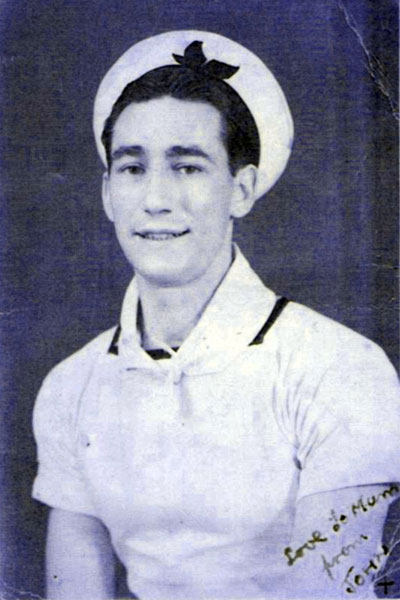 John's daughter Sue Houghton (Nee Jones) sent these photos to the original HMS Gambia website.
John's daughter Sue Houghton (Nee Jones) sent these photos to the original HMS Gambia website.
The photo of John was taken in Madagascar in 1942.
The the image is of the flyleaf of a bible that was issued to him in September 1945 in Japan
John passed away in 1967.

Robert Edward (Bob) Kennedy Royal Marine
From Veteran Stories: Robert Edward Kennedy - The Memory Project
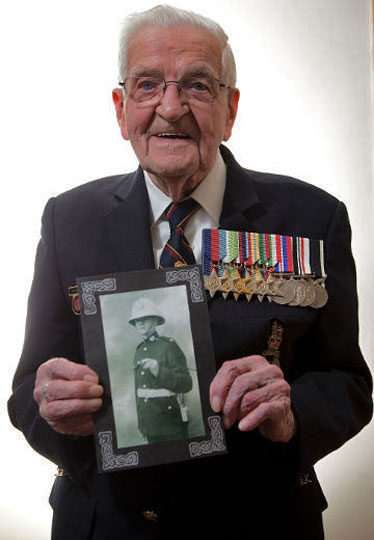 My name is Robert Kennedy. I joined the Royal Marines in September 1937, and my service career took me around the world. During my service during the war, part of it was with the home fleet in the North Atlantic. We ran from there to the Mediterranean, on board HMS Naiad – a flagship from the 15 Cruiser Squadron, eastern Mediterranean.
My name is Robert Kennedy. I joined the Royal Marines in September 1937, and my service career took me around the world. During my service during the war, part of it was with the home fleet in the North Atlantic. We ran from there to the Mediterranean, on board HMS Naiad – a flagship from the 15 Cruiser Squadron, eastern Mediterranean.
I took part in the evacuation of Greece and the Battle of Crete, May 1941. The ship was damaged during that Battle of Crete, and after repairs we went on back to the Mediterranean fleet convoys to Malta. During the very rough days, Malta suffered by aerial bombardment – Stukka dive-bombing – and the convoys from Alexandria to Malta, they were heavily bombed, and merchant ships carrying supplies to Malta, on a lot of occasions, quite a few of the merchant ships were sunk. The odd one would get through with vital supplies required.
My ship was torpedoed by a German U-boat on the 11th of March, 1942. From there, we went to a naval camp just outside of Alexandria in the desert, and then we were shipped on board a troop ship to Durban, South Africa. We were in camp there in Durban for two or three weeks, until such times as the Battleship Valiant came down from the Mediterranean, and into dry dock in Durban for engine repairs, and then from there, when she was ready to join the fleet, we sailed for Mombasa, East Africa.
We joined the eastern Mediterranean fleet. We were there with the eastern Mediterranean fleet until such times as we were returning back to the UK. I left the Valiant there. I took a course – a sniper's course. After the course was completed, I got some foreign service leave and was shipped to Ceylon. Did some jungle training there, with the intentions of operating behind Japanese lines in Burma, but one of the British Cruisers was damaged off the coast of Burma, and a couple of marine gun-layers was killed, so they asked for gun-layers to volunteer to go aboard the New Zealand Cruiser, Gambia. Twelve thousand tons, triple six-inch guns; so that's where I finished up, with the Gambia.
From I Joined up to see the World - The London Free Press - September 2, 2010
Bob Kennedy steps up to the microphone, straightens his tartan cap and glances down at the next bawdy song he'll sing to entertain guests who have come to his south London home to celebrate his 90th birthday. He's the headliner at his own party and that doesn't surprise those who know him best - he's told jokes and has sung songs to friends, family and fellow veterans for as long as they can remember. If someone's surprised, it's Kennedy himself, not that he's the life of the party but that he's alive at all. It's not the first time he's stood on his birthday in awe at his own mortality.
Sixty-five years earlier, Kennedy felt a similar blend of joy and relief as he stood on the deck of HMS Gambia in the Bay of Tokyo, part of an Allied armada there as Japanese leaders signed a surrender that officially ended the Second World War. The Allied force was overwhelming, especially the Americans, and U.S. General Douglas MacArthur timed the ceremony so that as the Japanese leaders lifted the pen to sign surrender documents on the deck of the U.S.S. Missouri, thousands of !American planes flew just overhead.
That night, Allied soldiers celebrated and those in the British fleet were treated to a double tot of rum - about five ounces - and the one and only beer they'd get on a naval vessel. That day became VJ-Day in Canada, short for Victory Over Japan Day. It would be mostly overlooked in Europe and celebrated with aplomb in the United States, where the Japanese attack on Pearl Harbour had been the first on !American soil since the War of 1812.
For Kennedy, that day meant something more personal: He'd live to see more birthdays after what before had seemed like a path to certain death. From the sunlit room of his kitchen in South London, the Glasgow native recalls how he grew up in the shadow of a military base where he delivered milk to married soldiers and their families. His Scotland of the 1930s was one where men struggled to find work in the face of the Great Depression, so at age 17, Kennedy signed up to become a Royal Marine. "I joined up to see the world. I didn't think there would be a bloody war," he says.
Kennedy pulls out a framed black-and-white photo of his graduating class of 1938, points to several and lingers at one. "Captain Phillips. He was killed at Dieppe. Quite a few of the boys were killed at Dieppe." Kennedy was assigned to man the big guns for the British fleet, first in the Atlantic Ocean, where the Royal Navy struggled with German U-boats to control the shipping lanes.
His closest brush with death came in 1942 in the Mediterranean Sea. The Allies had been using the island of Malta to attack Axis convoys taking supplies to armies in North Africa, so when Nazis blockaded the island, the Allies sent military convoys to get supplies to Malta. Kennedy was assigned to man the big guns of the flagship of the 15th Cruiser Squadron, HMS Naiad, and in March it was lured from port in Alexandria, Egypt, by a false report of a damaged Italian vessel. The ship was in total darkness when Kennedy felt it jolted up from the sea, a torpedo from a U-boat exploding the engine room. The Naiad lurched to the right and quickly began to sink. With explosions rocking the ship, Kennedy and a crew mate made their way to the stern, where seawater was already coming over the deck.
They jumped into waters cold from winter, kept afloat by a life jacket the sailors called a Mae West for the way the chest inflated. Hours passed. Kennedy's arms and legs began to stiffen from the cold. He prayed. In his mind he saw the faces of family back in Scotland, urging him to hang on. After five hours, they were spotted and picked up by a destroyer. Eighty-three of his crew mates perished. But while that night was awful, worse things awaited in the Pacific, where Kennedy joined HMS Gambia, which had been lent to the New Zealand navy.
Tales of Japanese brutality were rampant and Kennedy didn't doubt them when the Allied fleet came under assault at the battle of Okinawa. Kamikazes struck all five British carriers, says Kennedy, slapping his kitchen table five times. One took aim at the Gambia, barely missing. "If you hadn't had a bowel movement for awhile you had one right there. They'd come out of the sky out of nowhere and come straight down." He dreaded what was planned next: An invasion of Japan itself. With mountains framing most of the main island, the only place for an amphibious landing was Tokyo Bay.
The Japanese were dug in and some estimated more than a million Allied casualties if civilians resisted, too. In early August 1945, the Gambia and Allied fleet were ordered to back away 640 kilometers (400 miles) from Japan. Something was up but no one knew what. The world would learn August 6. A single !American plane dropped the first atomic bomb on Hiroshima, destroying everything within two kilometers of its detonation, killing 66,000 people from the blast and unleashing radiation that would kill countless more in coming years. On August 9, a second atomic bomb was dropped on Nagasaki, killing between 40,000 and 75,000. Six days later, Japan surrendered. There would be no invasion.
In the weeks after the war, Kennedy went ashore in Japan to bring back Allied prisoners from a prisoner-of-war camp outside Kobe. The city was beautiful but the camp was awful: Prisoners who survived brutal treatment were bone thin, their bellies distended. One told Kennedy he ate snakes and rats to keep alive. Estimates vary considerably of casualties in the Pacific War that began December 7, 1941, when the Japanese launched attacks on Pearl Harbour and British Malaya. But the Americans alone estimated 41,322 soldiers in their force were killed and another 129,274 injured before the Japanese surrender August 15, 1945.
"I don't know, to be quite honest with you, how I got to this age," Kennedy says, his eyes growing watery, his voice tired. "I don't know, It surprised me. Between the battle of Crete, the Malta convoys, the Pacific fleet, Okinawa. Jesus, I'll tell you. Everyone dropped down on their hands and knees and thanked God they dropped those (atomic) bombs. Without that I doubt I'd be here today."
Kennedy lifts his head with resilience learned over nine decades. "I'm here and I'll have a party here Saturday. I'll put on my highland kilt and I'll have a glass of Glenfiddich single malt scotch." How the Scotsman settled in London is an unlikely tale.
After the war, he decided to move to New Zealand, whose beauty had struck him while he served in the Pacific. The normal route of travel east was off-limits because of unexploded mines along the way. So Kennedy went west, with plans to get to Vancouver and sail across the Pacific. With only 50 English pounds - about $200 Cdn - he sailed to New York, then took a train to Toronto. Only then did he learn Vancouver wasn't close to Toronto. "Little did I know the expanse of Canada."
The fare was costly and Kennedy was almost out of money so he hooked up with a fellow Scot who helped him get a job at the Royal York Hotel as a bellhop. "It was the biggest hotel in the British Empire, with 2,300 rooms. I know that because at 2 a.m. I delivered bills under all the doors."
He planned to earn enough to continue his journey. But there was a setback, one he didn't want to discuss, only saying it was related to his military service and he ended up in Sunnybrook Military Hospital. There Kennedy would fall in love with a Canadian nurse named Jessie Bruce and she with him. "Can you see why?" he beams showing her photo.
In 1949 the couple moved to London. Kennedy worked with National Defence and the Ontario Liquor Board. They became parents - Bruce and Jim Kennedy still live in the city - and later grandparents. A long life has brought joy, but also loss. Friends died. Kennedy stopped playing golf in his mid-80s because no one was left to play with. A few years ago Jesse died.
Once there had been 28 Royal Marines in the London region; now it's down to seven. But one tradition endures. Kennedy didn't take many wartime souvenirs and most of what he did he gave to friends. But he still has three Japanese glasses he believes were used by its navy to celebrate victories at sea. Kennedy isn't one for sake - he swears Glenfiddich has been the key to his longevity. Each birthday he fills those glasses with rum. "Every 2nd of September my boys and I have a tot of rum and we say, 'Thank God.'"
From Russia Honours Veteran With Medal, Vodka - The London Free Press - April 28, 2016
When your life is the world of diplomacy and your boss is Vladimir Putin, you're not easily surprised. But the head of the Russian delegation in Toronto was taken aback this month when a 95-year-old Londoner, to be honoured for heroism during the Second World War, not only walked himself into the reception area, but passed up coffee and tea for a vodka. "He was quite surprised I walked in instead of being carried," Londoner Bob Kennedy said.
Kennedy was among four Canadians given medals but the only one of the quartet healthy enough to make the trip to the Toronto consulate on the 14th floor of a tower on Bloor Street. In his case, it was for his role in Britain's Royal Navy, which protected merchant ships taking vital supplies from Loch Ewe, Scotland, through frigid waters north of Norway, to Murmansk, a Russian port above the Arctic Circle.
Kennedy manned the big guns that kept Nazi warplanes away and did so knowing a sinking ship would mean a quick, icy death. "Your life in the water was three minutes," he said. Later in the war, in 1942, Kennedy experienced life in a foundering ship when the flagship of the 15th Cruiser Squadron, HMS Naiad, was sunk in the Mediterranean Sea. He spent five hours in cold water before being spotted and rescued by a destroyer.
Seventy-four years later, it was the vodka served at the consulate that was ice-cold. The guests had been offered tea or coffee, but Kennedy's son Bruce, among family members who accompanied him, asked about vodka. "It was very nice," said Bob Kennedy, who attributes his longevity and good health to a nightcap of Glenfiddich single-malt Scotch.
The Ushakov Medal, named for the 19th-century patriarch of the Russian navy, Fyodor Ushakov, was originally reserved for Soviet war-time heroes and later expanded to peacetime service and acts by foreign nationals who protected the Soviet fortunes during the titanic clash with Hitler. It was Putin, the Russian president, who signed the decree that awarded medals to Kennedy and others.
"According to Russian President Vladimir Putin decree No. 131 . . . you are awarded the Russian Ushakov Medal for personal courage and bravery displayed during the Second World War," Consul General Vladimir Pavlov wrote. Asked about the Russian leader, Kennedy said, "Putin is not the laughing type. He doesn't smile so much . . . But it's a lot better than when (Josef) Stalin was around."
Kennedy was born in Glasgow, Scotland in 1920 and grew up close to a military base. He delivered milk to soldiers and their families. In 1939 he signed up to become a Royal Marine. He would survive attacks by German U-boats and Japanese kamikaze pilots and see the war end five years later on the deck of HMS Gambia, in Tokyo Bay, when Japanese leaders signed a surrender that officially ended the Second World War. From a solitary marine in a massive Allied armada, to the only veteran in a Toronto consulate, Kennedy has felt the loss of comrades and time: "There's not too many of us left."
When I was putting this page together I noticed an odd coincidence. The first picture is of Jim Murray who now lives in New Zealand. The second is of Bob Kennedy who now lives in South London, Ontario. But in August 1945, they were both on HMNZS Gambia in the Tokyo Bay. Jim as a gunner in "A" turret, Bob as a Royal Marine.
On August 20, there was a RN/RM landing force from the ship that took the surrender of Yokosuka Naval Base. It would be nice to know if both these men were in that land force and that was where the glasses were liberated from.
James was one of the crewmen who were part of the RN/RM landing force from the ship that took the surrender of Yokosuka Naval Base on August 20, 1945. The platoon of Royal Marines were led by Captain Blake, RM and two platoons of seamen from Gambia with company headquarters under the command of Lieutenant-Commander G.R. Davis-Goff DSC, RNZN took the surrender of the Japanese Naval Base at Yokosuka. The men of the force included Watty Bird, James Murray and Jack Stuart.
Dennis King (C/KX725495) Stoker 1st Class
Dennis joined Gambia in 1945, after travelling to Perth, he then made his way to Sydney by rail, only to find out that the ship had sailed without him. Dennis finally caught up with the ship in Guam, from where they went to sea and was present at the surrender of the Japanese Forces.
 From Kirkwood, Warrant Officer R.W. - National Museum of the New Zealand Navy
From Kirkwood, Warrant Officer R.W. - National Museum of the New Zealand Navy
Ronald W. (Ron) Kirkwood joined the New Zealand Division of the Royal Navy as a stoker in 1932. After service in the cruiser HMS Dunedin he was sent on loan to the United Kingdom in early 1936, serving in the destroyer HMS Hostile transporting civil war refugees from Spain after which he was posted to the battleships HMS Ramillies and HMS Resolution.
In early 1939, Kirkwood returned to New Zealand in HMS Achilles and was immediately sent for mechanician training in Australia. He rejoined HMS Achilles on completion of his courses and describes the bombing of HMS Achilles X turret in the Solomon Islands area. Kirkwood spent the remainder of the war in the cruiser HMNZS Gambia. He was a member of the commissioning party that brought the cruiser HMNZS Bellona out to New Zealand.
Ronald Kirkwood retired from the RNZN in October 1949 having attained the rank of Warrant Officer.
This newspaper clipping was on the original HMS Gambia Association website but there were no other details about it. HMS Gambia was commissioned into the the Royal New Zealand Navy in May 1944, as these men were celebrating the 55th anniversary of that, I think this article was published in 1999.
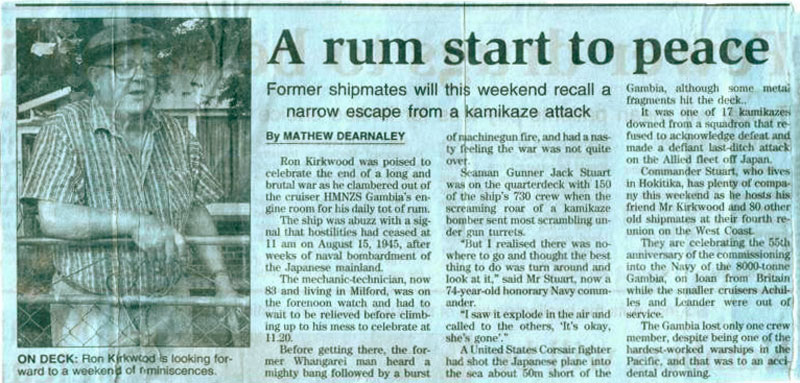
A Rum Start to Peace
A Rum Start to Peace
By Mathew Dearnaley
Former shipmates will this weekend recall a narrow escape from a kamikaze attack
On Deck: Ron Kirkwood is looking forward to a weekend of reminiscences.
Ron Kirkwood was poised to celebrate the end of a long brutal was as he clambered out of the HMNZS Gambia's engine room for his daily tot of rum.
The ship was abuzz with a signal that hostilities had ceased at 11am on August 15, 1945, after weeks of naval bombardment of the Japanese mainland. The mechanic-technician, now 83 and living in Milford, was on the forenoon watch and had to wait to be relieved before climbing up to his mess to celebrate at 11:20.
Before getting there, the former Whangarei man heard a mighty bang followed by a burst of machine gun fire, and had a nasty feeling the war was not quite over.
Seaman gunner Jack Stuart was on the quarterdeck with 150 of the ship's 730 crew when the screaming roar of a kamikaze bomber sent most of scrambling under gun turrets. "But I realized there was nowhere to go and thought the best thing to do was turn around and look at it," said Mr. Stuart, now a 74-year-old honorary Navy Commander. "I saw it explode in the air and called to the others, 'It's okay, she's gone'."
A United States Corsair fighter had shot the Japanese plane into the sea about 50m short of the Gambia, although some metal fragments hit the deck. It was one of 17 kamikazes downed from a squadron that refused to acknowledge defeat and made a last-ditch attack on the Allied fleet off Japan.
Commander Stuart, who lives in Holkitika, has plenty of company this weekend as he hosts his friend Mr. Kirkwood and 80 other old shipmates at their fourth reunion on the West Coast. They are celebrating the 55th anniversary of the commissioning into the Navy of the 8,000-tonne Gambia, on loan from Britain while the smaller cruises Achilles and Leander were out of service.
The Gambia lost only one crew member, despite being one of the hardest-worked warships in the Pacific, and that was to an accidental drowning.
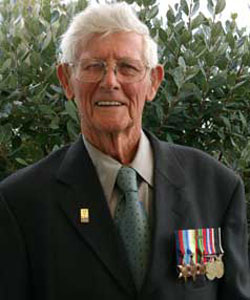 Geoffrey Hugh (Geoff) Logan (Reg. No. 2109) was still a young teen when, at 15, he joined the New Zealand Division of the Royal Navy in 1941, as a sea boy, signing on for 12 years and training as a telegraphist. In the last years of his life, Mr Logan was a resident at Ruawai House in Feilding, New Zealand.
Geoffrey Hugh (Geoff) Logan (Reg. No. 2109) was still a young teen when, at 15, he joined the New Zealand Division of the Royal Navy in 1941, as a sea boy, signing on for 12 years and training as a telegraphist. In the last years of his life, Mr Logan was a resident at Ruawai House in Feilding, New Zealand.
After learning Morse code and the skills of a navy serviceman, at the HMNZ Philomel training facility in Devonport, Auckland, in early 1942, Sea Boy Logan went to war. "Dad comes from a family of five boys with a strong history of giving service," Mr Logan's son Marc said. "Dad's father Rueben Logan served in World War I at Gallipoli and at the Battle of the Somme 1916. Reuben's brothers, George and Stanley, were both killed at Gallipoli."
On the HMNZS Achilles, Mr Logan served in the Pacific Ocean. On January 5, 1943, a Japanese bomb destroyed the HMNZS Achilles X turret and three months later the HMNZS Achilles docked at Portsmouth, England, for repairs. The crew of the HMNZS Achilles was transferred to the HMNZS Gambia. "On the HMNZS Gambia we travelled through the Mediterranean, to the Indian Ocean, where the ship carried out trade protection duties, working with the British Far Eastern Fleet, based in Ceylon (now Sri Lanka)."
Mr Logan served in three oceans, the Pacific, the Atlantic and the Indian Ocean. Returning to New Zealand, still in the New Zealand Navy, Mr Logan worked at Auckland Naval radio station then transferred to Waiouru Naval radio station. "One of the first things I did on arrival in New Zealand was purchase a BSA motorbike" said Mr Logan.
He married Dorothy Marchioni in 1948 and they had four children: Marc, Judith, Peter and Diane. Sadly Peter has died. "While serving at the Naval radio station, Waiouru, I had the unpleasant task of taking the message regarding the loss of life of my brother in-law Bobbie Marchioni," Mr Logan said. "He was only 18 and killed while serving in the New Zealand Navy in the Korean War 1950 to 1953."
Leaving the navy in 1952, Mr Logan went to Christchurch to train as a teacher. His first five years in his new career were spent at Hiwinui School followed by Palmerston North Intermediate Normal School. He retired in 1985 after many years at Monrad Intermediate School.
Mr Logan presided over the local chapter of the King's Empire Veteran Association, a national organization established in the 1900s. Its membership is conditional upon having been awarded a medal for serving in a New Zealand defence force overseas during a foreign conflict.
For many years Mr Logan travelled New Zealand on behalf of the organization attending to the welfare of veterans. "And that is a lifetime defined," he said.
The above was written in 2010 when he was nearly 84. Mr. Logan passed away peacefully in the presence of his family at Aroha Lifecare, Palmerston North, aged 87, on February 2, 2013.
George MacLeod - Royal Marines
George was a Royal Marine Musician, who having completed his training in the Isle of Man in 1942, was drafted to join HMS Furious in the Atlantic. As can be seen from the article below, George MacLeod volunteered to join the Navy and was drafted to HMNZS Gambia, in which he served until 1946. Sadly, George died on May 15, 2012, aged 86.
This article appeared in the Rotorua Review of Tuesday, April 3, 2007
After years of giving orders, George wants to go quietly
By Phil Campbell
George MacLeod has been barking orders on the parade ground for 49 years – on Anzac Day this year, he will get the men fell in for the last time. He just wants to ease out with a whimper.
"I think 50 years is quite long enough," Lieutenant Colonel MacLeod told the Review.
In that time, he has marshalled soldiers who fought in World War I, World War II, Korean and Vietnam War conflicts.
He has also barked orders for one day of the year to Air Force, Army and Royal Navy cadets.
In a brusque, regimented but almost raffish way, Lt. Col. MacLeod has seen the popularity of the parades grow in the last decade where turnouts possibly resemble those of 50 years ago – at least in numbers.
Then, fatigues were worn at secondary school on Fridays for drill, with annual camps at military bases (this correspondent once attended an NCO course at Burnham).
MacLeod said he felt he was lucky with his health, "but I'm finding it very, very difficult to march now – we are fading away".
Since 1957, Mr. MacLeod has looked forward to his Anzac Day. "I've enjoyed the experience," he says. "In the 1950 the majority were World War I people still marching – a terrific number, in fact, but there are none whatsoever now.
"And there were quite a small number of World War II people.
"The other interesting thing is that some of the cadets who marched in those days are now superannuates – the 15 and 16-year-olds."
Number counting was difficult, but 200 was a rough guess, a figure has diminished over the years. School cadets bolstered the numbers.
All being well, Mr. MacLeod said he would still attend Anzac Day parades.
"I don't think I'll miss anything, but I won't be doing as much marching," Mr. MacLeod said.
"The whole atmosphere is great and I still intend attending as long as I'm still here." Mr. MacLeod has suggested the well-known John Marsh, who served in Vietnam, could take over the role. Mr. MacLeod, who succeeded Tom Luffey, a World War I major, who oversaw Anzac Day parades from 1945 to 1957. Mr. MacLeod,, who "served on" with the Hautakis post war, led at the Anzac Day as captain, but was subsequently promoted to his present rank, serving also in the territorials. Retired from the Army in 1974, the 82-year-old Mr. MacLeod saw service at 15 years 10 months, from 1941 to the Isle of Man for basic training boarded the aircraft carrier Furious to Murmansk, then to the Mediterranean, the Far East where he was at the end of the war when the treaty signed in Japan.
"There were representatives from each of the services from all countries who had taken part in the war there," Mr. MacLeod said.
"Troops from HMS Gambia were among the first troops to land in Japan, with a selection of marines and sailors aboard the Missouri to witness the signings.
Service leaders – generals and admirals – through the Far East were arranged in synchronous signings at the end of the Japanese conflict.
Yep, he says, people have been kind enough to say they want him to stay. Lt. Colonel MacLeod has modestly accepted the sentiments.
We have tried to keep quiet about it as requested. It is difficult muffling the farewell of a genuine Rotorus character – the parades were worth attending to see him in action. Like the ageing soldiers on his parade, who occasionally missed a step or two, who were not always eyes front, or who were seconds behind orders like Corporal Jones of Dad's Army fame, we are happy to say we failed. We can already sense the Lieutenant Colonel ordering a fizzer – a military escort to a bar at the Rotorua RSA.
Jack Maben - Royal Marines
The following was provided to the HMS Gambia Association by Jack's son, Peter.

Jack Maben and fellow Royal Marines
From left to right, Marines Steptoe, Bowkett, Henshaw, Stockton, Griggs, Brown, Ellis, Smith and Jack Maben.
Jack Maben grew up in Kent Jack with his younger brother, Kenny, who died of pneumonia shortly after the end of the war. Jack joined the Royal Marines shortly after the outbreak of WW2 after previously training as a barber. He married Elizabeth (Betty) and they enjoyed a short honeymoon in Torquay before he re-joined the war.
Prior to joining Gambia, Jack served on HMS Shropshire from January 7, 1942 to April 5, 1943 on South Atlantic convoy escort duties.
Jack joined HMS Gambia at Liverpool on September 23, 1943, the day after Gambia was transferred to the Royal New Zealand Navy, and was based at Plymouth for a short while. Gambia was in the Azores at Horta on December 15, 1943. During 1944, Gambia did a lot of travelling and was in Gibraltar on February 2, Alexandria on February 6, Aden on February 13, Ceylon (now Sri Lanka) on February 20, Wellington on November 4, Auckland on November 8, Dunedin on January 26, 1945 and Sydney on February 17.
Jack landed at Asuma for the liberation of the prisoners of war on August 30, 1945 and was present for the occupation of Yokusuki Naval Base on September 3, 1945, and then on to Tokyo.
He returned to Auckland for a long leave and then returned to the U.K. on March 27, 1946 at which time he was demobbed and left the Gambia.
One of Jack's descendants has created a website about him at Grandad's War.
Thomas Murray Mason
I am grateful to Charlotte Watson, Thomas' granddaughter for the following information. Thomas served in the RNZN from 1939-1945 and after being transferred from Swiftsure, served on HMS Gambia from September to December, 1945 as radarman. Thomas passed away in 1997.
Peter Ngamoki
I am grateful to Peter's son, Willy for providing the following information.
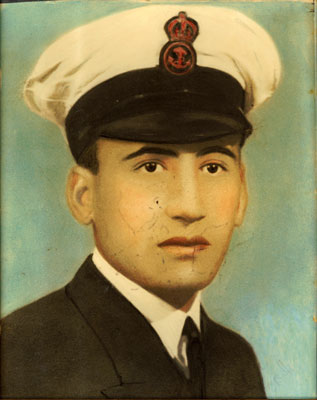 Peter was a Petty Officer Stores Assistant who served on HMNZS Gambia during WWII. His son, Willy, said that he was at the surrender in Tokyo and reported the surrender proceedings back to NZ by radio in the Maori language. He passed away in 1982 as have his 4 brothers who also served in WWII, 3 in the 28th Maori Battalion and 1 in the RNZAF.
Peter was a Petty Officer Stores Assistant who served on HMNZS Gambia during WWII. His son, Willy, said that he was at the surrender in Tokyo and reported the surrender proceedings back to NZ by radio in the Maori language. He passed away in 1982 as have his 4 brothers who also served in WWII, 3 in the 28th Maori Battalion and 1 in the RNZAF.
Alf Simpson NZ9139
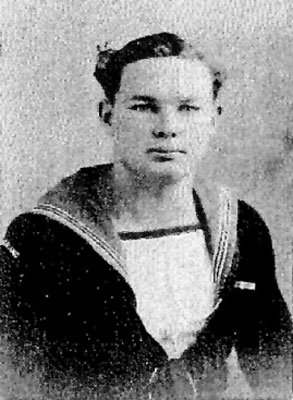 Alfred "Alf" Alexander Simpson served on HMNZS Gambia from 1944 to 1946. The following is taken from Poppy Places: Alf Simpson Drive, Whitianga
Alfred "Alf" Alexander Simpson served on HMNZS Gambia from 1944 to 1946. The following is taken from Poppy Places: Alf Simpson Drive, Whitianga
Like his father, Richard (Alf) Alfred Simpson who joined the Army and served in France in World War 1, Alfred Alexander Simpson made the decision to join the armed forces to serve his country during a time of war. Alfred (Alf) Alexander Simpson applied to join the Navy in 1943 and this is his story of his time on HMNZS Gambia:
On the 8th November 1944 the Gambia sailed into Auckland, going straight into dry dock for maintenance where she remained until late January 1945. Our class was on board the Gambia during this time, learning about our new ship.
Maintenance completed it then was out into the Hauraki Gulf to do our sea trials, part of which included achieving maximum speed. Using full power from 72,500 ship horse power, turning four props we hit a top speed of 33 knots, equivalent to 61.1 km/hr. At this speed standing on the quarter deck of a 10,000 ton warship was a spectacular site charging along dragging her stem through the water appearing to be below the boiling foaming surrounding sea.
Sea trials over, the Gambia sailed down to the South Island on the 27th January 1945 to allow residents of Dunedin and Christchurch a look over New Zealand's newest warship, arriving back in Auckland on the 4th of February.
The next day the battleship HMS Howe, cruiser HMNZS Achilles and three Australian destroyers arrived in Auckland. Several days later along with the Gambia this fleet of warships sailed out into the Hauraki Gulf to undertake combined exercises, which included live gun fire. A large number of fighter bombers flew out from the Hobsonville and Whenuapai Air Bases, coming in from all angles, giving us an example of what we may expect up in the Pacific war zone.
During one night the Howe and Gambia fired a number of broadsides off the Coromandel coastline out towards Little Barrier. These 14inch guns on the Howe were the largest ever fired in New Zealand and were heard loudly in Kuaotunu, where my parents were farming and all around the Auckland area. It lit up the night sky and fair shook the settlement of Waitakaruru on the Hauraki Plains. This being remembered by my future wife Dorette Perry and her Parents who lived there.
The Gambia later in the day time dropped a depth charge, used for submarine defense. The underwater explosion from this sent a huge volume of water 60ft into the air and left a massive lot of snapper and other fish floating on the surface of the water.
On the 14th Feb 1945 the Gambia sailed out of Auckland with the Howe and her three Australian destroyer escort, travelling inside the Great Mercury and Ohinau Island. On board the Gambia was our class now of only 33 and a total crew of just over 900, with me aged 16 years 5 months the youngest member of the crew.
It took four days to reach Australia. Once clear of the coast, we began the practice of sailing a zig zag course which was a normal procedure for ships during the war. This made it more difficult for submarines to line up the target, that wasn't on a straight course. Submarines were always the greatest danger anywhere at sea. Once clear of New Zealand Captain William Poulett Royal Navy addressed the Gambia crew to inform us that we would be part of the British Pacific Fleet operating in Japanese waters, where attacks by suicide planes (kamikaze pilots) were sinking or severely damaging a lot of USA ships and in preparation for this we will be constantly carrying out anti-aircraft gunnery practice with our 4 inch 40mm and 20mm close range weapons.
We arrived in Sydney a huge impressive city with a harbour full of warships of all sizes. We sailed slowly up the harbour under the bridge and tied up at the naval base. All mail now leaving the ship was censored and this remained until the end of the war making letters home difficult to write not being able to describe what was happening.
On February 1st we departed from Sydney in company with part of the British Pacific Fleet including four large aircraft carriers, two battleships and a number of smaller warships. It was a hot sunny day and blowing a gale out in open waters. It was the first really rough experience for us with carriers taking seas over their bows which were forty to fifty feet high. It remained stormy all the way up the Australian coast.
Seven days after leaving Sydney we reached Manus Naval Base in the Admiralty Islands. While there around I08 of the crew, including myself got the mumps. We were all sent onto the Hospital Ship Oxfordshire for about a week. On 22nd March, back on the Gambia, we sailed out of Manus with part of the British Pacific Fleet and joined up with a convoy of some eighty odd, ships. Antiaircraft firing practice at targets being towed by aircraft was a constant activity. Before all this live practice the whole crew were allotted an action station, where about ninety per cent of the personnel are below deck or in enclosed gun turrets.
I was given an action station on 40mm Pom-Pom guns and then later, part of a crew of a 4inch gun turret where I was able to see all of the action that involved our ship and the whole British Pacific Fleet of thirty seven warships right up to the Japanese surrender.
We arrived with the convoy at Leyte Gulf in the Philippines where hundreds of other ships were waiting to sail north into the war zone.
On the 31st March 1945 we left the Gulf of Leyte with the whole British Pacific Fleet. The Gambia being the central ship there were four large aircraft carriers around us, each about 2000 yards away and the battleships Howe and King George V steaming in front of them with six cruisers, 21 Destroyers and some smaller ships scattered around.
We headed for the Sakishima Island where the Aircraft Carrier's planes bombed several airfields. Only one Japanese suicide plane got through our fighter plane screen and disabled the destroyer HMS Ulster with a near miss. The Gambia was instructed to tow her back to Leyte Gulf, which took three days travelling at about 8 knots and left us as a dangerous possible submarine target. This was later confirmed when we heard that the USA cruiser Indianapolis, about that time coming into the Philippines under radio silence after delivering critical parts for the atomic bomb, was sunk by a Japanese submarine and no one new for three days by which time 800 odd crew members had perished, many of them eaten alive in the shark infested waters. A book was written about this tragic event after the war, "In Harms Way" by Doug Stanton and available at most libraries.
On completion of the towing of HMS Ulster the Gambia immediately sailed from San Pedro Bay after loading a cargo of many disposable fuel tanks to be used by the carriers Seafires and Fireflys to increase their range. With the Gambia's sister ship, HMS Uganda, which had only three 6 inch gun turrets and in place of the 4th 6inch turret on the quarter deck were multiple 40mm pom-poms and all sorts of close range anti-aircraft weapons, being very handy in a suicide plane attack.
We were required back with the British Pacific Fleet as soon as possible. So with a couple of destroyers and the two cruisers steaming at a steady 28 knots we were back with the fleet within 36 hours compared with the 3 days taken by the towing job.
During the following days in mid-April we bombarded the Sakishima group of Islands and also Formosa, now called Taiwan. Closing into the cost line we fired 230 rounds of 6 inch shells, just on dawn and still quite dark. The Gambia's port side 40mm Pom-Pom guns accidentally shot down a USA Hellcat fighter, mistaken for a Japanese suicide plane. At that time I was part of the starboard Pom-Pom gun crew. Unfortunately this happened on many occasions with other ships. With a vast number of warships and planes, identification had to be made in seconds due to suicide attacks.
Around this period we were at sea for weeks at a time in the Okinawa area south of Japan, where the United States had 1200 warships of all sizes and every so often we would see this vast fleet in the mornings supporting the marines landing on Okinawa. Okinawa was required for a base in preparation for the pending invasion of the Japanese mainland.
About every ten days at sea, we would retire back from the war zone and meet up with the fleet oil tankers and supply ships for fuel and a large range of supplies. On one occasion we spent eighty five days continuously at sea following this procedure.
We did return to Leyte occasionally for rest periods. Being in the middle of summer and around 100 degrees we spent a lot of time swimming over the side. It was a Royal Marines job, to stand in a high prominent position with a loaded high powered rifle, to be used in this shark infested area on any shark sightings.
Back at sea on the 9th of May, the fleet was attacked late in the day, when our fighter planes were unable to stop all of the large number of Japanese suicide bombers. About 2km away on the starboard side of the Gambia the carrier Victorious was attacked from one plane directly above; with it exploding in the middle of the flight deck and another coming in at sea level, crashing along the length of the flight deck.
On our port side at the same time the Carrier Formidable was hit by a third plane from directly above. While this was happening, the battleship Howe steaming in front of us was firing all close range weapons at another Japanese plane coming in at the stem. In the last seconds desperate gun fire caused it to veer off and crash into the sea on her port side. A few minutes later the pilot's body attached to a small parachute, floated past our starboard side. Our official photographer on the Gambia took several photos of all this action. On board the Victorious, there were thirty four casualties including seventeen killed in that attack.
On the 26th of May the Gambia left the main fleet sailing south to Manus and on to Sydney arriving there on the 3rd of June. She went straight into dry dock for hull maintenance and other repairs.
On 28th of June we sailed out of Sydney back to Manus and North into Japanese water joining up with the British Pacific Fleet, now part of the USA third fleet. From now until the end of the war any aircraft attack would be suicidal. We were now operating some 100 to 300 miles out to the East of Tokyo, from where our carrier planes were attacking Japanese mainland targets.
Many of our planes were coming back with damage including no under carriage or only one wheel down, parts of wings missing etc. causing dangerous situations trying to land, with some ditching in the sea close by hoping to survive and be picked up. This was on going through July and early August.
On 9th of August the Gambia closed into mainland Japan around midday, in company with seven destroyers, six cruisers and three American battleships we began bombarding the Kamaishi steel works city.
A spotter plane flying above the steel works target area, sending radio messages back to the Gambia to indicate where our broadsides of 12 six inch shells were landing, this being necessary as the steel works was back behind a small mountain range. At times when the Japanese antiaircraft shells started getting close to our spotter plane it was forced to climb or dive evasively to a different altitude so as to continue radio signals of the correct range. All the warships involved had to tum together, going up and down the coast, when the maximum range of about 20,000 yards was reached. In local terms this would be equivalent to firing a broadside from the seaward side of Whale Rock exploding in any part of Whitianga town-ship some 18km away. At one stage shore gun fire started to come out from the steep cliffs on the coast, with the larger ships out of range a couple of destroyers were ordered to close in. With several broadsides from their 4 inch guns they brought down huge chunks of the cliffs which soon put an end to that threat. One Japanese plane came out and was quickly shot down with all warships having a crack at it, as it came out of the high cloud cover.
After about three hours the American Commander on one of the battleships called for a halt in the bombardment, and withdrawal from the coast line. At this time the Gambia's 6 inch guns were loaded and ready and asked for permission to fire the last broadside. That turned out to be the last shots of the Second World War as on our return back to the main fleet news came that the atomic bomb had been dropped and the war would be over soon.
My mother kept some of the letters I wrote to my parents. One of which I wrote 64 years ago said "well the war is over although we have been attacked by Japanese planes since the cease fire". Three hours after peace was declared a Japanese plane diving towards the fleet to attack us was engaged by our fighters overhead. After a few bursts from our fighters the Japanese plane blew into a hundred pieces directly overhead. Some of the pieces of the plane landed on our ship and several stray bullets also hit us, but fortunately no one was hurt. The bomb that the plane was carrying burst in the water about one hundred yards from us. The Gambia also fired at the attack plane which turned out to be the last shots in world war 11 for the second time.
On the 13th September the Gambia anchored in Wakejama [Wakayama] Bay to become involved in the evacuation of three thousand POWs. They were loaded onto two large hospital ships and one of the British aircraft carriers. The POWs were showing signs of the starvation and cruel treatment received.
We are now part of the British and USA fleet waiting off the coast until it is declared safe to enter Tokyo Bay. During this time a fly past of over 1000 planes from the carriers took place and with an impressive show of power the vast fleet of ships maneuvering in unison with changes of course.
On the 31st August 1945 we finally sailed into Tokyo Bay and anchored quite close to the Battleship Missouri. With binoculars we were able to see all those present on the quarter deck of the Missouri at the signing of the Japanese surrender during this historic occasion on the 2nd of September 1945.
The next day we went ashore, boarded a train which was crowded with only Japanese women and children and travelled up to Tokyo and saw the result of constant bombing. Only the odd large buildings here and there were left standing. Lots of kids were following us around and asking for chocolates and cigarettes in exchange for hands full of Japanese money in notes which we were able to use to buy the odd souvenir.
During this operation we were struck by a typhoon which started with a heavy swell. A big American cruiser close to us was rolling around spectacularly. By dusk with the wind at 90 knots it had turned the sea into a flat foaming area. A couple of hours later with the wind still increasing things were becoming dangerous and required all ships to weigh anchors and head out to sea and ride it out.
On the 11th October Gambia was relieved of her duties by HMNZS Achilles and sailed from Tokyo Bay for Manus under peace time routine which included a slower more economical speed and I must say less excitement than during the war with being continually on alert to all sorts of possible attack. We arrived 17th October at Manus for refuelling, then on to Sydney arriving 23 October, and on home to Auckland arriving 30 October 1945, having been away for seven and a half months experiencing all of the above.
The Gambia was tied up at the naval base from 30th October waiting to be returned to the British Government. We sailed out of Auckland on the 12th Feb 1946 for Sydney, with a reduced steaming, crew which included my class that had joined up on the 3rd Feb 1944 arriving back in Sydney for the fourth time in the last year.
On Victory Parade Day, 8th June, there were over twenty thousand from many different countries marching. We marched six miles through the streets of London and back to Kensington Park camp. The next day the King and Queen made an informal visit to the complete New Zealand contingent, Princesses Elizabeth, our present Queen and her sister Margaret, 17 years old, the same age as myself, were also with the Royal party.
On the 1st August 1946 after being on the Gambia a year and eight months, we New Zealanders finally left to join the 5,700 tons light cruiser Bellona, which needed only half the crew of about 980 that was required to operate the 10,000 ton Gambia. We were now based near London in the Thames Estuary. On the 24th October we sailed from England in the Bellona out into the North Sea, through the straights of Dover, down into the North Atlantic where we ran into a full blown Atlantic storm, worse than anything we had experienced before, with the Bellona rolling at times up to 45 degrees.
I must emphasize that this article is taken from Poppy Places: Alf Simpson Drive, Whitianga
Jack Stuart
From Top Gun Crewmen Visit WWII Pilot Who Saved Their Ship - Sun-Sentinel - October 25, 1990
Top Gun Crewmen Visit WWII Pilot Who Saved Their Ship
By Steven R. Biller, Sun-Sentinel, October 25, 1990
Walk into Marshall Lloyd`s waterfront Delray Beach home, and he will take you first to his favorite painting. It is a colorful representation of an endlessly celebrated day -- the last day of World War II -- when a U.S. Navy Corsair pilot saved the New Zealand cruiser Gambia from a kamikaze air attack.
Two Gambia crewmen, Jack Stuart and Colin Howat, saw the painting again last weekend when they arrived from Hokitika, New Zealand, for a second reunion with Lloyd, the pilot who saved their ship. The two sailors still talk about the painting and the day their ship was saved
It was the morning of Aug. 15, 1945. A "cease hostilities against Japan" order came at 11:23 a.m., to signal the end of World War II. Lt. Cmdr. Stuart and Howat stood on the Gambia`s top deck with 188 others, all proudly waving their white caps in celebration. Suddenly, a kamikaze plane came darting violently toward the Gambia. Stuart yelled for his shipmates to scatter, but there was no place the crew could run.
An American pilot appeared from the clouds and sent the kamikaze plane flaming into the water. "No Japanese were supposed to be flying there," Lloyd`s wife, Virginia, said. "No one will ever know if that Japanese pilot knew the war was over." The kamikaze pilot was aiming for the British Carrier Indefatigable. But the U.S. pilots shot and disabled the plane, sending it straight for the Gambia. The Japanese plane was shot down so close to the Gambia that many of the crewmen salvaged parts of the plane`s wreckage from the deck of the cruiser and kept them as souvenirs, Virginia Lloyd said.
Stuart was determined to meet his rescuer. His search lasted 25 years, because the New Zealand crew thought a British Seafire saved their cruiser. "I wrote to a British historian, but it turns out that there was no Seafire flying that day," Stuart said. A log that listed "kills" made for Aug. 15 showed that the plane was an American Corsair.
A Navy officer in Washington helped solve the mystery. In 1986, a list of names led Stuart to Lloyd. "I got right on the phone," Stuart said. "I was never so excited. But I didn`t realize when I called that it was 3 a.m. in the United States."
Nearly two years later, the Lloyds and the Gambia crew would reunite in New Zealand. Expecting a reminiscent, easygoing 30-day visit to Hokitika, a small town of about 3,500, Lloyd arrived a hero at a bombastic celebration. There was a parade. Children were dressed in sailor`s outfits. Shopkeepers placed welcome signs in their windows. "Everybody wanted to talk to us," Lloyd said. "I remember the day like it was yesterday. All the kids were dressed up and they all very hospitable."
Said Virginia: "One of the most touching memories about the 1988 reunion in New Zealand was speaking to the wives of the men who were on the Gambia. They kept coming up to Marshall to touch him on the arm to thank him, because without Marshall, they wouldn`t have had their husbands or their children any more."
A Gambia replica was built on a storefront to commemorate Lloyd`s camaraderie. "It was the biggest event that happened in our little town," Stuart said. More than 250 Gambia crew members and their families who attended the reunion insisted that a 50th anniversary reunion be held in New Zealand in 1995.
Meanwhile, Stuart and Howat made their way to the United States, and the Lloyds have their guests` vacation planned. Sightseeing trips will include Cape Canaveral, Epcot Center and Key West. They will see the Philharmonic Orchestra of Florida and cruise the Intracoastal Waterway on the Lloyds` 30- foot boat. Although Stuart and Howat are startled by Florida`s attractions, they treasure equally brief moments in the Lloyds` den where there is an array of wartime memorabilia. They were speechless while staring at a photograph of the 1988 reunion.
Edward Courtney Thorne
The future Rear Admiral EC Thorne, CB, CBE, RNZN Chief of Naval Staff: July 1972 – December 1975, served on HMNZS Gambia as a Lieutenant at the end of WWII during the time the ship was returned to Britain. The RNZN Communicators Association website has a biography of this distinguished sailor.
This was on the original HMS Gambia Association website, so I kept it.
On April 1, 1945, while operating with a task force to the south of Japan, HMS Ulster was bombed by a Japanese aircraft. The bomb, which was estimated to weigh between 250 and 500 lbs. fell only a few feet from the vessel and the explosion blew a large jagged hole in the plating on the starboard side. The damage was extensive with the ship sinking 29ft but remaining afloat and upright.
HMS Ulster was taken under tow by HMS Gambia to Leyte Gulf in the Philippines. The 760 mile trip took three days at an average towing speed of 8 knots. Despite the tragedy there were some lighter moments. Being unable to make fresh water the crew of HMS Ulster were rationed to one cup of water per man, per day, to be taken as tea. There was no water for washing and no saltwater soap, so they rigged awnings slackly to catch rainwater, but it never rained for the time of the tow. They arrived at Leyte to a hero's welcome.
The damage HMS Ulster sustained is dealt with on other sites, such as Norrie's Net and World Naval Ships Forums. Two odes appeared about the incident on the original HMS Gambia Association site:
Take this chain
Take this chain from my arse and set me free!
I've dragged "Ulster" through many miles of sea'
Oh, the agony and pain, from that rusty anchor chain!
Take this chain from my arse and set me free!
Take this chain from my arse and let me be,
That damn boat nearly dragged the arse off me!
Dragging "Ulster" all those miles, that was worse than having piles,
Take this chain from my arse an' set me free!
Take this chain from my arse I've had enough!
Tell that boat where her cable she can stuff
Put an end to all this farce. Get this thing from off my arse!
Take this chain from my arse and set me free!!!
Rising Sun
There is a flag Eastern Climb
Its called the "Rising Sun"
It's been the curse of many a ship,
And Ulster sure was one
To Sakashima, Ulster came
At dawn on April One,
While Yanks to Okinawa came
To Quell the "Rising Sun."
An Aircraft flew down Ulster's side
Attacked by ev'ry gun,
And blazoned on the fuselage
We saw the "Rising Sun."
A bomb blew in the Ulster's side,
Her fighting days were done.
And five brave lads would never see
Another rising sun.
The years have numbered forty-five
Since Ulster's race was run,
And five lads died that we might see
This mornings rising sun
Though April Fools we well may be,
Today, we pray as one;
God took their souls that Easter Morn
To join his Rising Son
The RNZN Communicators Association has some great photos of HMNZS Gambia. Part one is here, and part two is here.
The following thumbnails are to main images that appear to have jumped ship and gone AWOL. Bill had a lot of images on his website, unfortunately all that could be retrieved from the Web Archive were the thumbnails. Until the original photographs can be found, they are simply presented here.
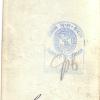 Censors approval stamp
Censors approval stamp This picture was discovered in the archives of the former Gambia Secretary, and it appears that it could be the ship's company marching to the ship in 1943
This picture was discovered in the archives of the former Gambia Secretary, and it appears that it could be the ship's company marching to the ship in 1943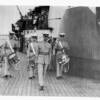 The caption to this image originally read, "RM Band marching onto the Quarterdeck for some occasion, but, in my day we always marched on from the opposite side, i.e., the Starboard Side. This picture appears to have reproduced on a photocopier, hence the lines in the picture which my photo editor has not been able to remove. Circa 1943-1945"
The caption to this image originally read, "RM Band marching onto the Quarterdeck for some occasion, but, in my day we always marched on from the opposite side, i.e., the Starboard Side. This picture appears to have reproduced on a photocopier, hence the lines in the picture which my photo editor has not been able to remove. Circa 1943-1945"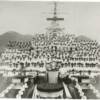 Ship's company, date unknown
Ship's company, date unknown Our lads
Our lads Royals alongside 4" guns
Royals alongside 4" guns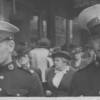 Doug Saunders and Keith Woodward in Queen Street, Auckland, 1944
Doug Saunders and Keith Woodward in Queen Street, Auckland, 1944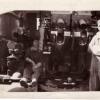 4" crew at rest
4" crew at rest GDP (gun direction?) crew
GDP (gun direction?) crew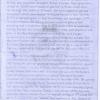 HMNZS Gambia Heroes Return newspaper article
HMNZS Gambia Heroes Return newspaper article Admiral Rawlings Address
Admiral Rawlings Address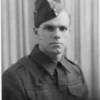 Royal Marine Len W. Kimber CHX/1706 in KD Battledress
Royal Marine Len W. Kimber CHX/1706 in KD Battledress Royal Marine Len W. Kimber CHX/1706
Royal Marine Len W. Kimber CHX/1706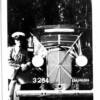 Royal Marine Len W. Kimber CHX/1706 with his charger
Royal Marine Len W. Kimber CHX/1706 with his charger Postcard of HMNZS Gambia
Postcard of HMNZS Gambia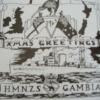 This looks like a map of HMNZS Gambia's travels
This looks like a map of HMNZS Gambia's travels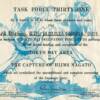 Task Force 31 Certificate
Task Force 31 Certificate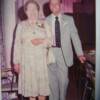 The late Len Kimber and his wife Eileen
The late Len Kimber and his wife Eileen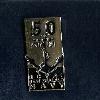 Lapel badge to celebrate 50 years of the Royal New Zealand Navy
Lapel badge to celebrate 50 years of the Royal New Zealand Navy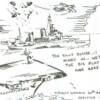 Beer Mat as used for the Fiftieth Reunion in NZ, kindly sent in by Keith Scott
Beer Mat as used for the Fiftieth Reunion in NZ, kindly sent in by Keith Scott Marshall O. Lloyd newspaper clipping
Marshall O. Lloyd newspaper clippingSources
Center for Research: Allied POWs Under the Japanese - a great collection of information including the fleet orders for 1945
HMNZS Gambia (Fiji-class Cruiser) - National Museum of the New Zealand Navy
Imperial Japanese Navy Submarine, Air Base and Marine Oil Terminal at Sabang, Sumatra by Bob Hackett with Sander Kingsepp
Japanese Operational Aircraft CinCPOA 105-45 - Naval History and Heritage Command
Naval History and Heritage Command
Poppy Places: Alf Simpson Drive, Whitianga
Quiet Papamoa Commemoration of 75 Years
The New Zealand Cruisers - Victoria University of Wellington
World War II Plus 70 Years: Seminar and Discussion Forum
